20 Top Sights of Lampang, a City Where Time Means Nothing (2025)
Lampang, affectionately known as Nakhon Lampang, shines as the third-largest city in northern Thailand and serves as the bustling capital of both Lampang Province and Mueang District. Rich in history, Lampang has also been referred to as Wiang Lakon and Khelang Nakhon in days gone by. As a thriving trading and transportation hub, this dynamic city seamlessly blends modernity with timeless charm. Visitors to Lampang can expect a delightful fusion of ancient temples, captivating cultural experiences, and friendly locals, all wrapped up in the warm and inviting atmosphere of this enchanting northern Thai city.
The Lampang route follows mostly straight highways, with occasional construction zones and plenty of trucks to overtake. Rest stops break up the ride and make the journey safer, while Lampang’s Old Town is worth exploring once you arrive. Watching your mirrors carefully is essential when overtaking heavy vehicles on narrow sections. For relaxed highway travel with space for a bag, choose a motorbike rental through our service.
Let’s take a trip to Lampang (Thai: ลำปาง, lam-bpaang) where time means nothing and visit 20 must-see tourist attractions: temples, museums and local architecture, including well-preserved Lannathai heritage sites waiting to be enjoyed by generations to come. Lampang city is a tranquil and fascinating place in northern Thailand, just 109 kilometers from Chiang Mai.
Things To Do
Wat Phra That Lampang Luang
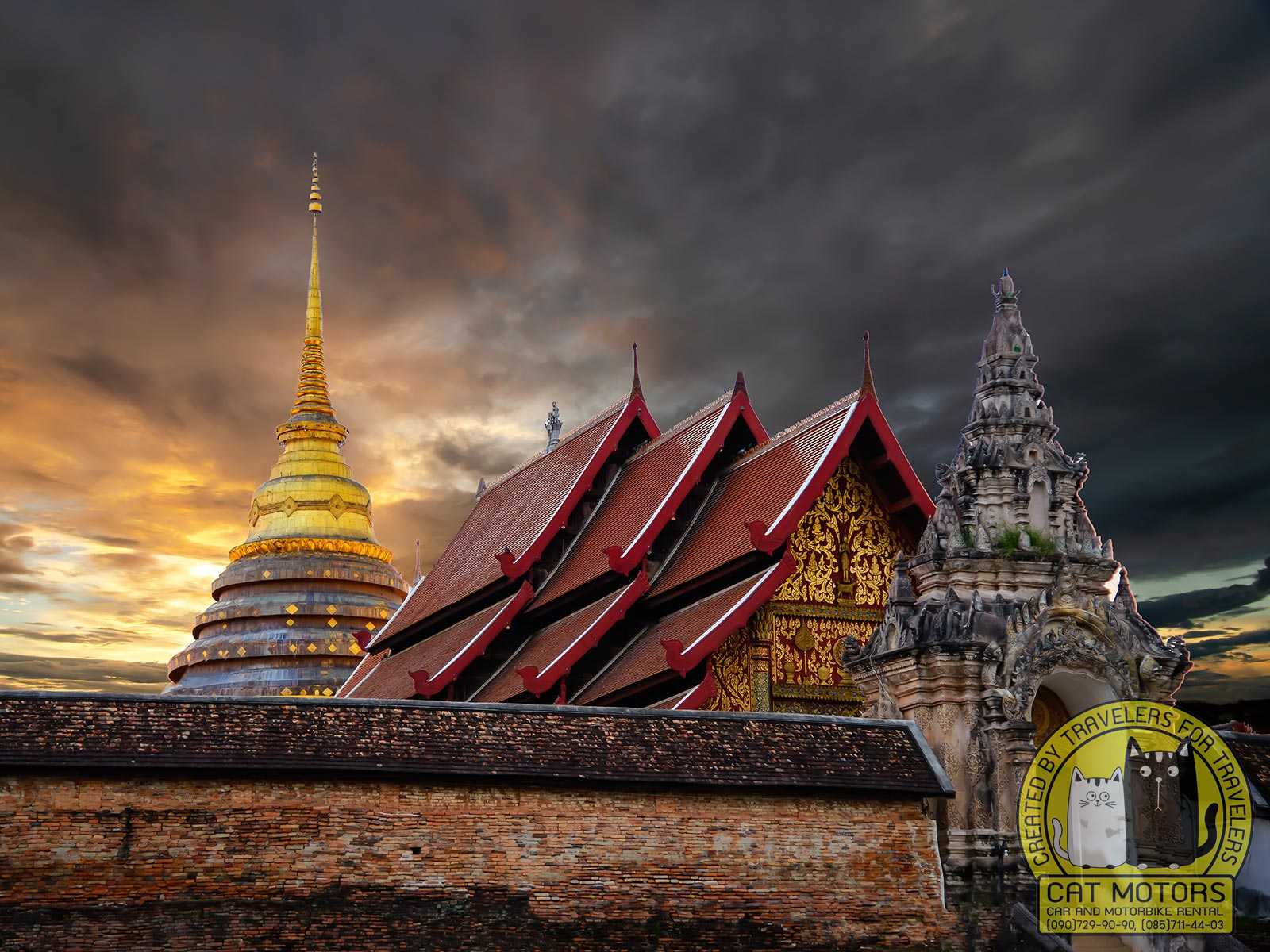
Wat Phra That Lampang Luang, the main holy temple of Lampang Province housing the relics of the Buddha, is an ancient and beautiful buddhist temple that is a sacred place of worship and pilgrimage for people born in the year of the Ox, according to Lanna beliefs.
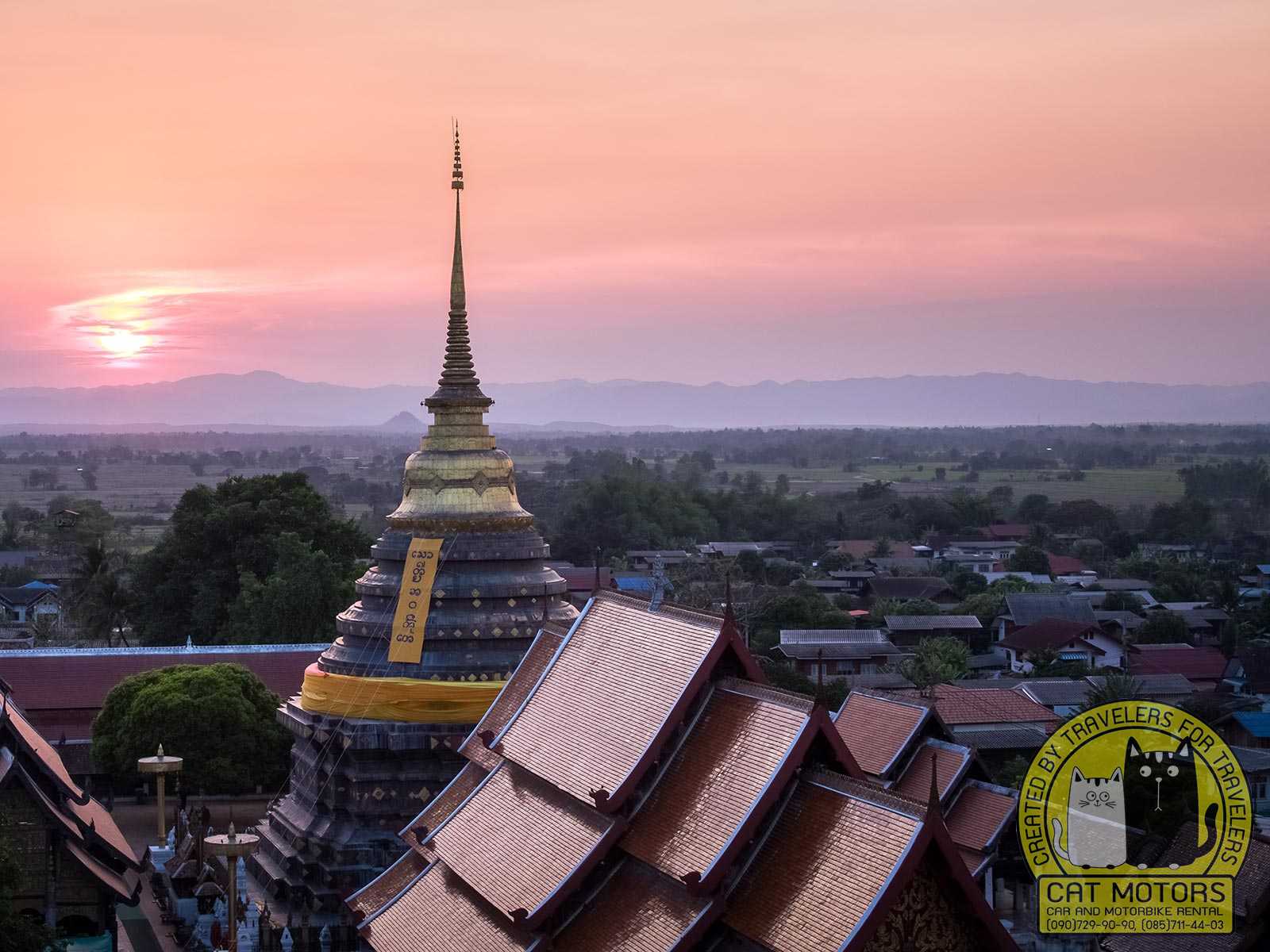
The chedi is the most notable feature of the temple. This massive stupa, erected in 1413 and a beautiful example of ancient architecture, was built in the Lanna style. The bell-shaped masonry Pagan-Lanna chedi is covered in brass plates. Legend has it that the stupa enshrines the hair of the Buddha.
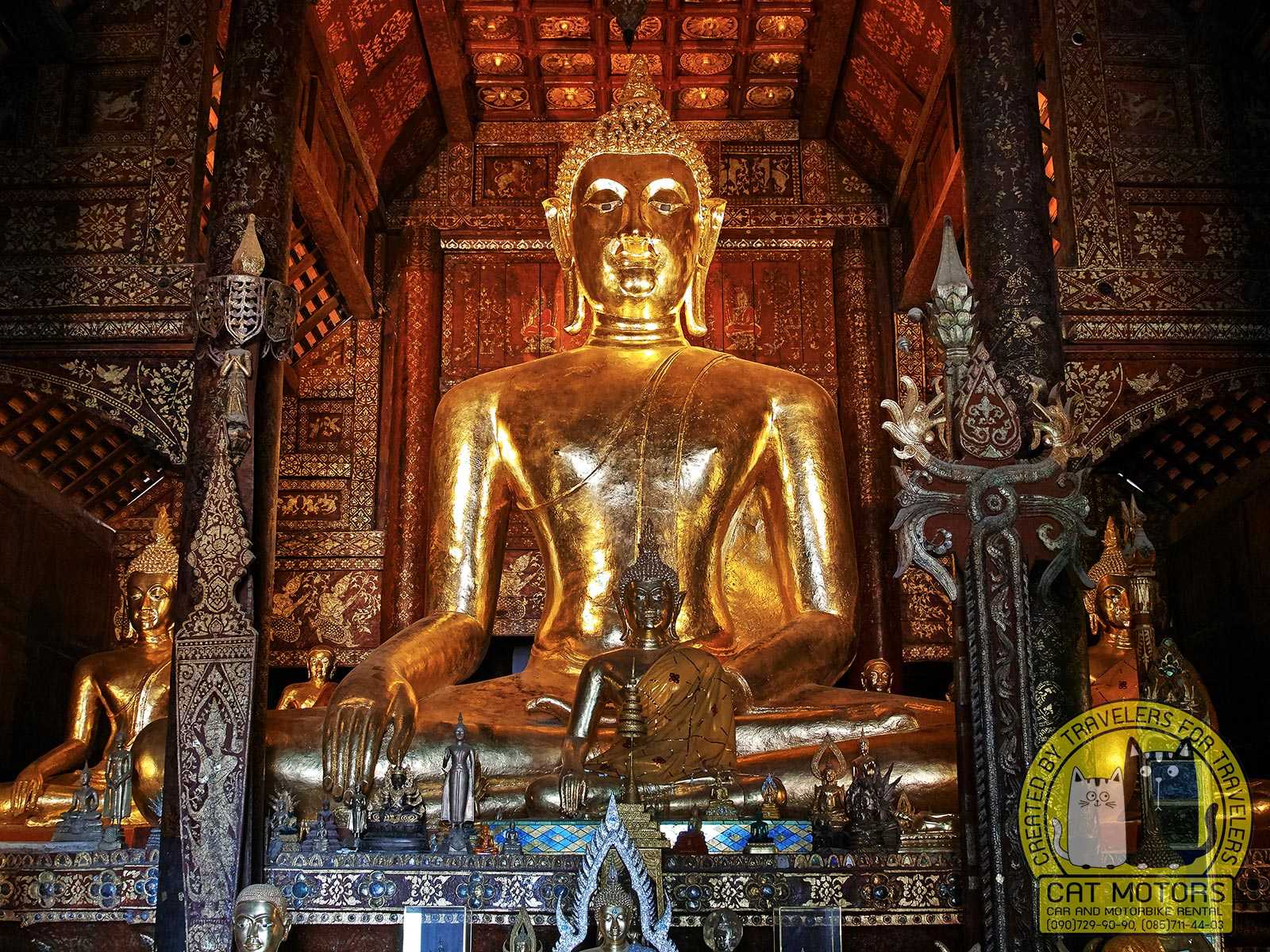
Phra Kaew Don Tao, also known as the Emerald Buddha, is inside the temple. Sitting in a meditative posture and made of jade in Lanna style, the statue has protected Lampang since time immemorial.
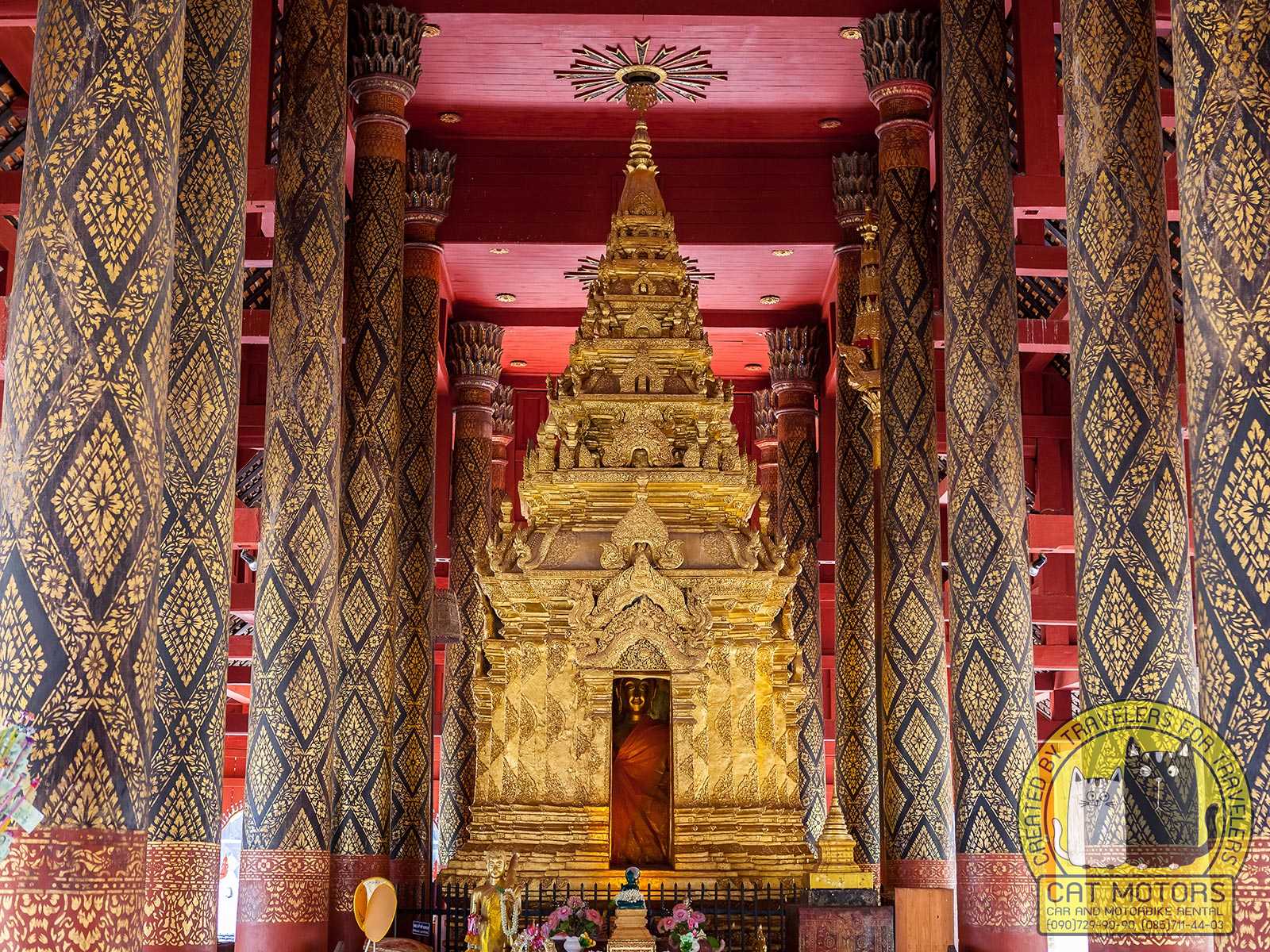
Another point of interest that’s worth seeing is the Ku Phra Chao Lan Tong in the main vihara. It is a large statue of Buddha, 2 meters wide and 3 meters high, according to legend cast by the son of King Tilokarat in 1589 from “a million gold”. By the standards of the ancient Kingdom of Lanna this is equivalent to 1200 kilograms of precious metal.
You can also take a photo with the Khong Arch, which was crafted by ancient royal artisans, and witness the phenomenon of the reverse shadow of the stupa in the hall where the footprint of the Buddha is contains. However, according to traditional customs, only men are allowed to enter this hall.
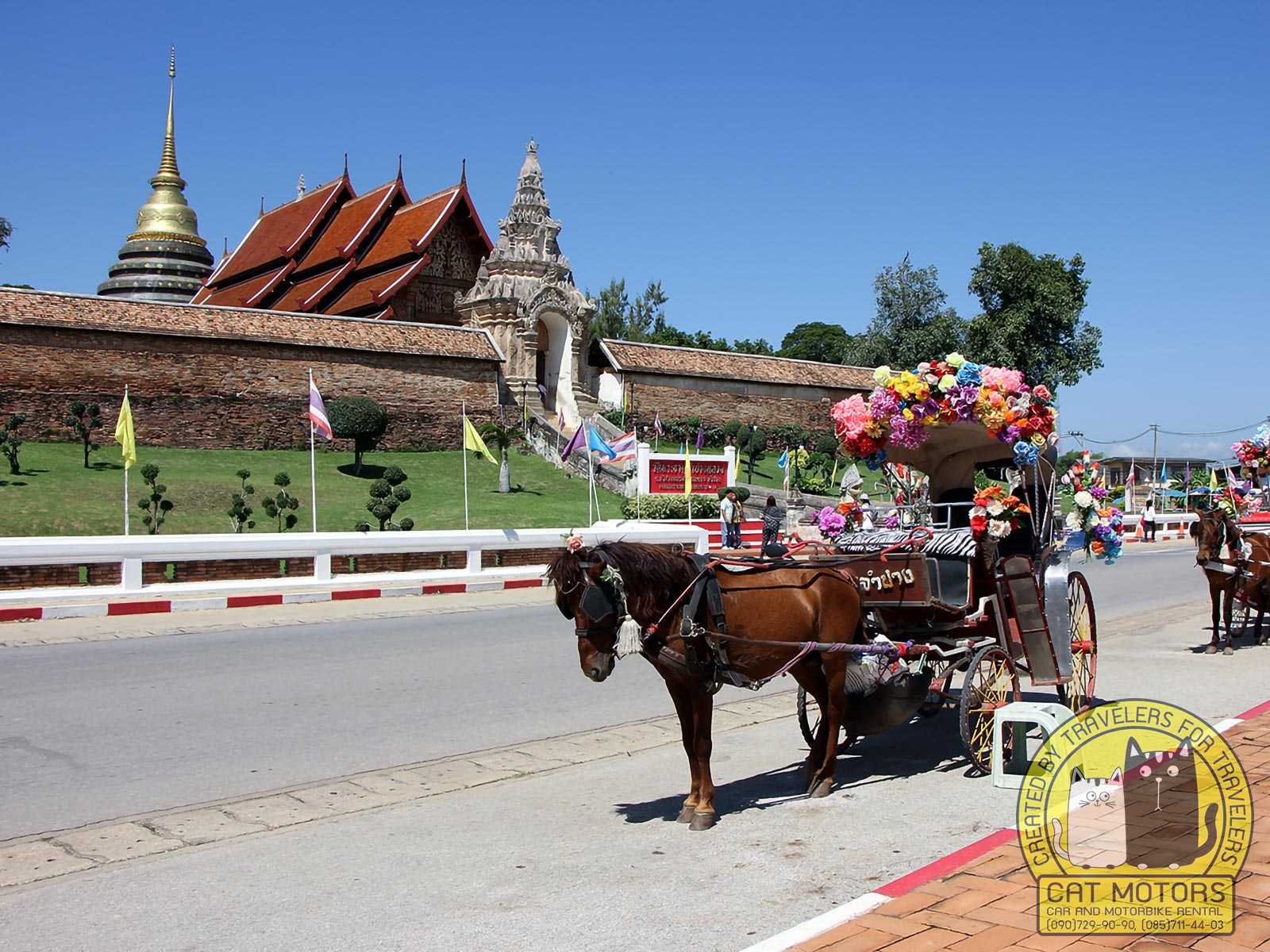
In front of the temple, you can catch a horse carriage to travel around the ancient city.
Mae Moh Mine

Mae Moh Mine is the biggest lignite mine in Thailand and is run by the Electricity Generating Authority of Thailand (EGAT). It supplies lignite to the Mae Moh Power Plant, where the coal is used to generate electricity.
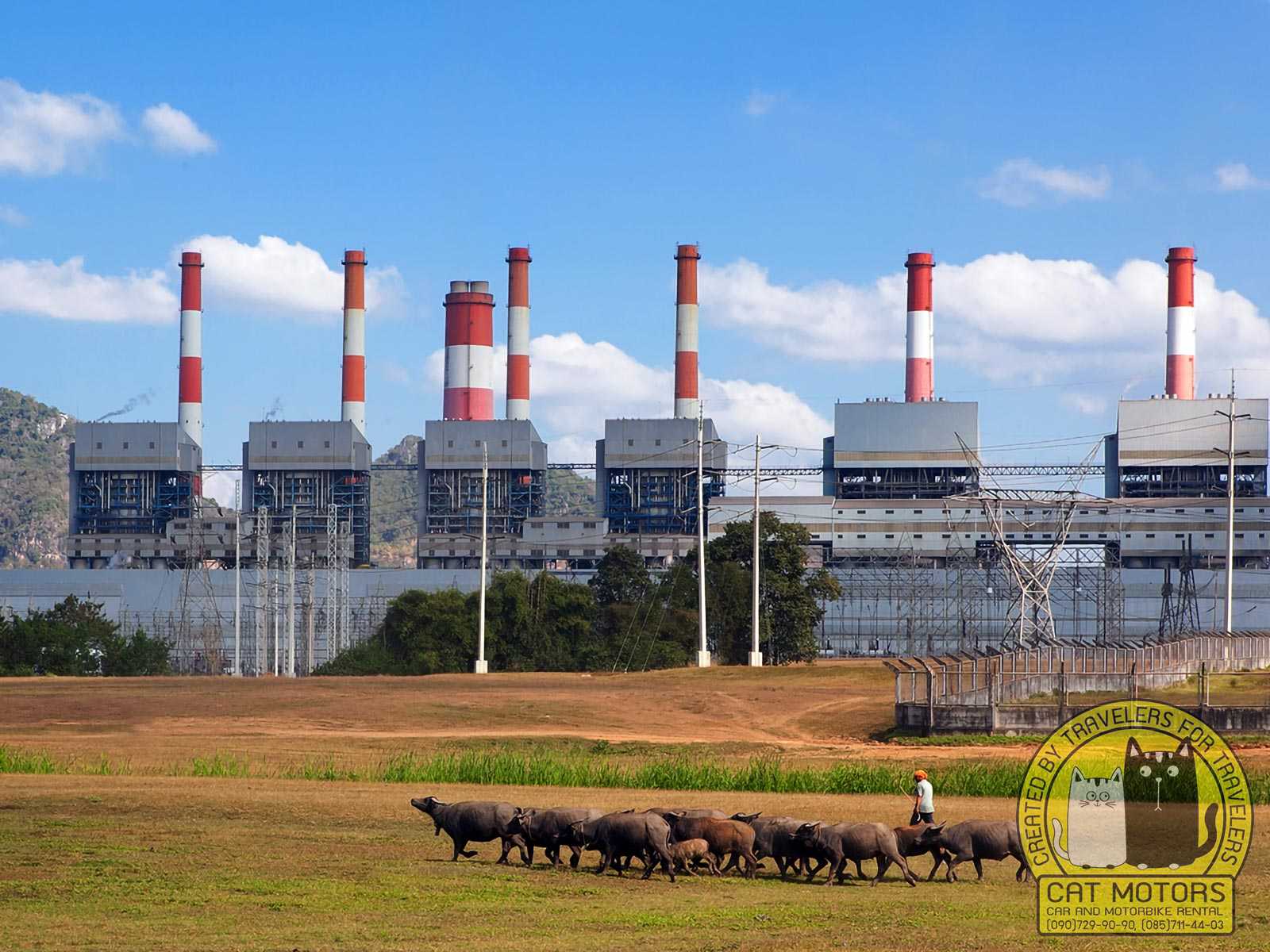
Despite this, there are many tourist spots within this area, such as the Lignite Coal Mine Study Centre Museum, which provides knowledge about geology and electricity production technology, and the Botanic Garden, a public park full of beautiful plants, which is an excellent destination for people who are fond of taking pictures. A slide on a grass field is also available for your enjoyment.
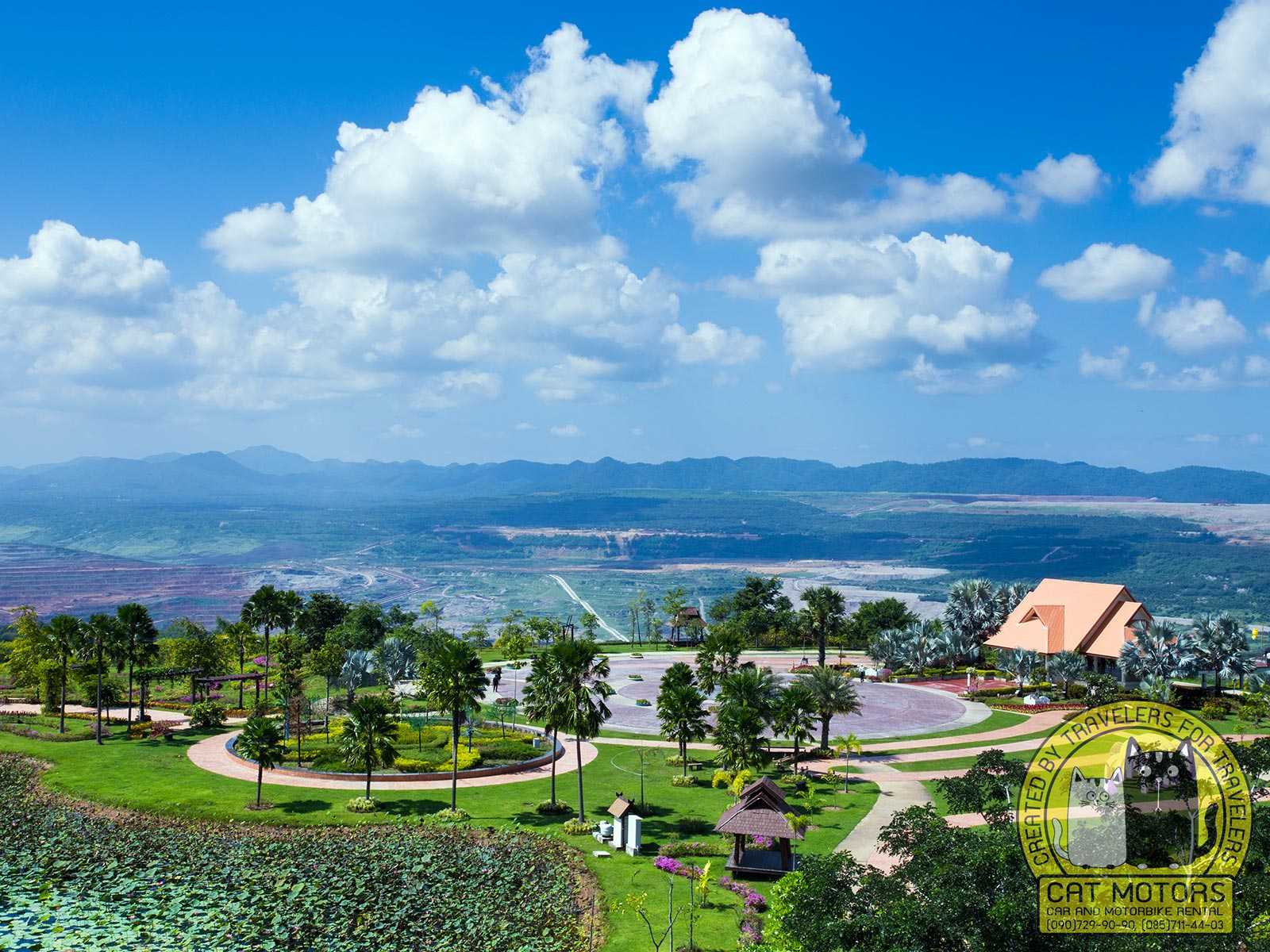
Other must-see places are the Public Park in Commemoration of H.M. the King’s 84th Birthday, which features stunning scenery, and the Bua Tong Field, where flowers bloom from November to December each year.
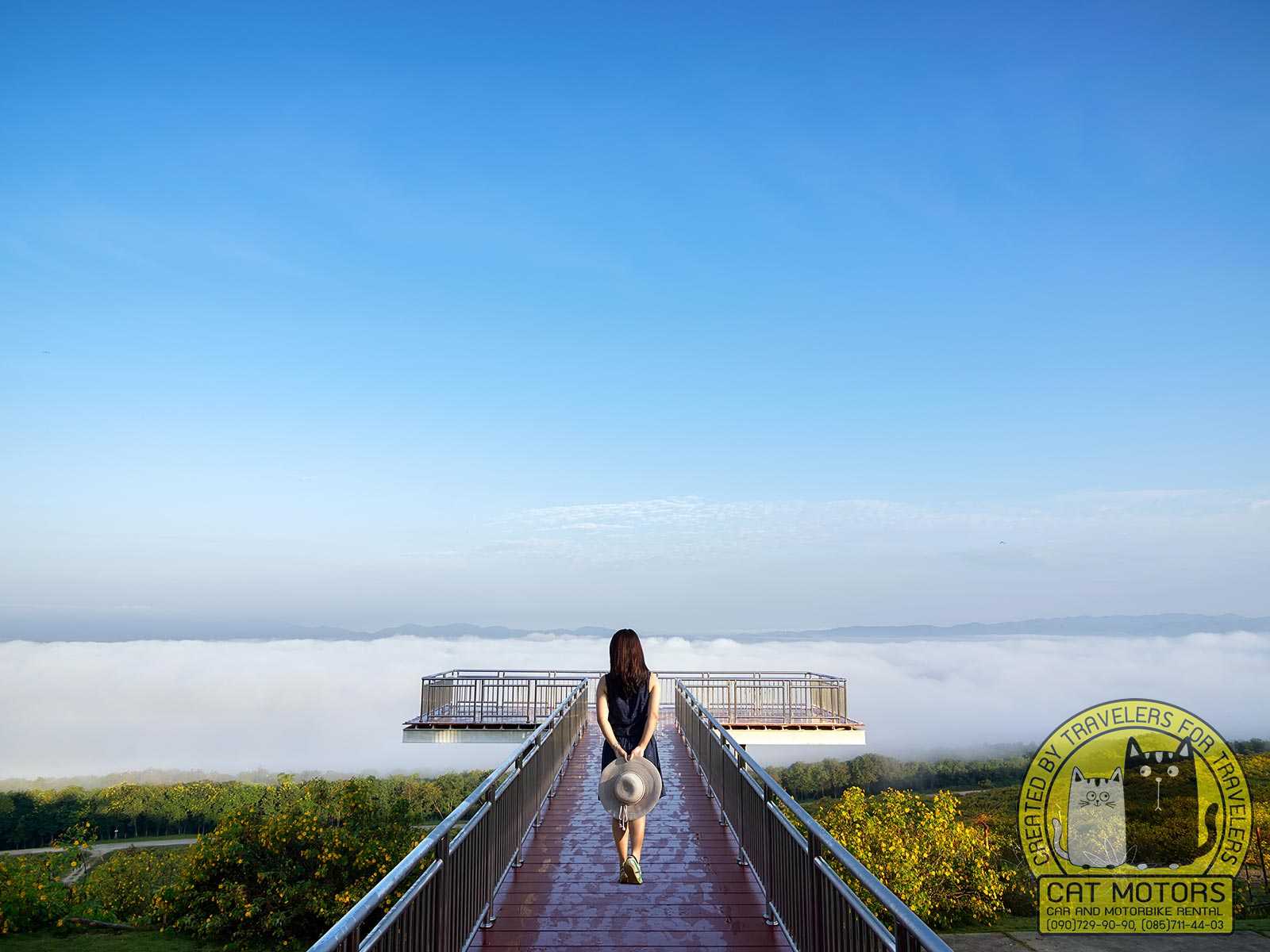
Thai Elephant Conservation Center
Let’s experience the loveliness of Thai elephants at the Thai Elephant Conservation Center. This is a place where elephants are cared for, and sick elephants are treated.
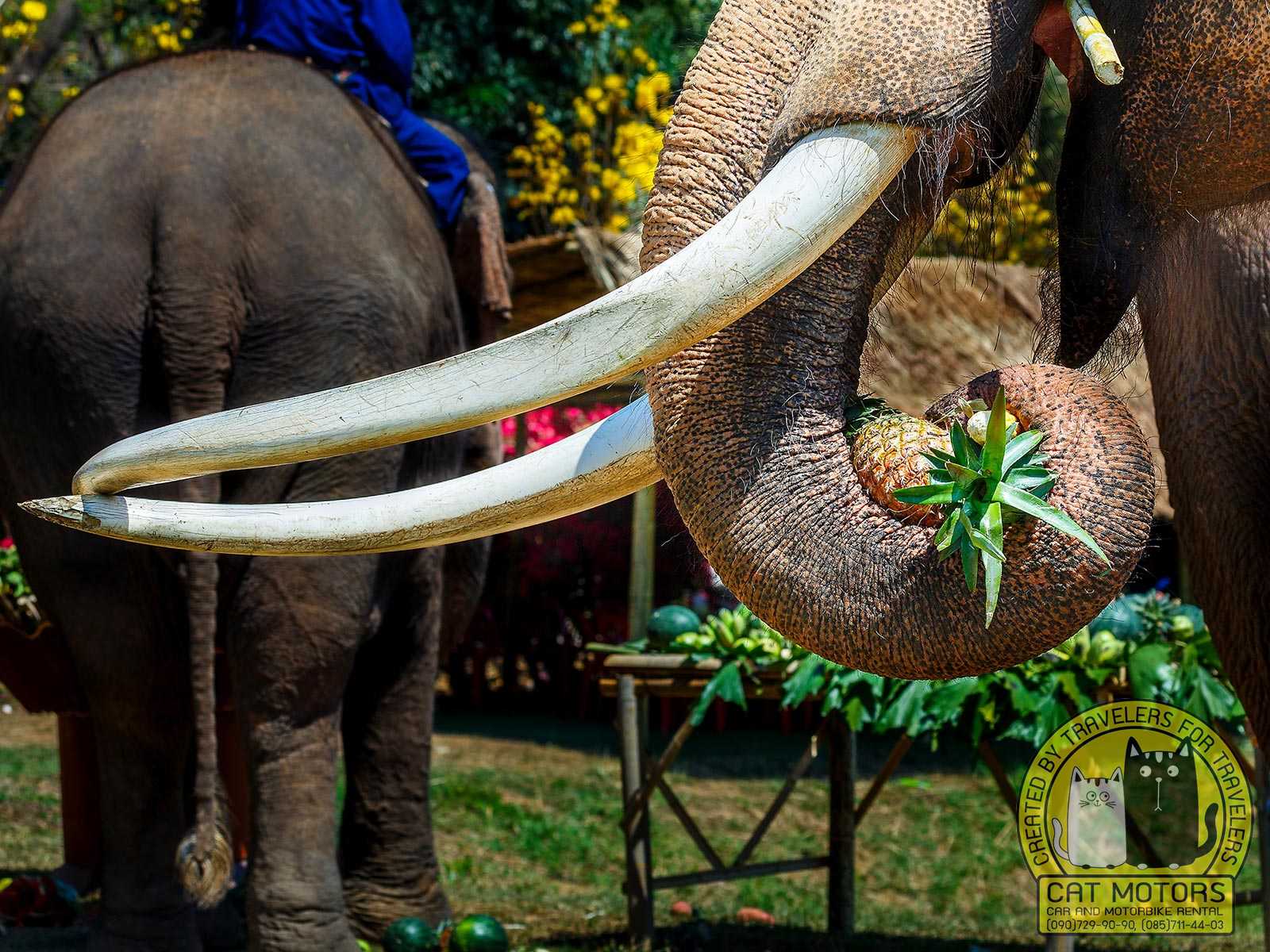
There are over 50 elephants in total. Tourists can visit here and do various activities, such as watching an elephant show, riding an elephant to see the local nature, watching an elephant bath, or staying overnight at a home-stay. In addition, you can enroll in a mahout training course and learn how to ride an elephant.
Chae Son National Park
Chae Son National Park, its rich and abundant forestland full of streams, wild animals, and beautiful natural resources, awaits you. Here, the natural hot water pool known as Chae Son Hot Wells is a must. You can boil hen or partridge eggs in the wells, eat the delicious spicy mineral egg salad, or take a mineral bath to brighten your skin.
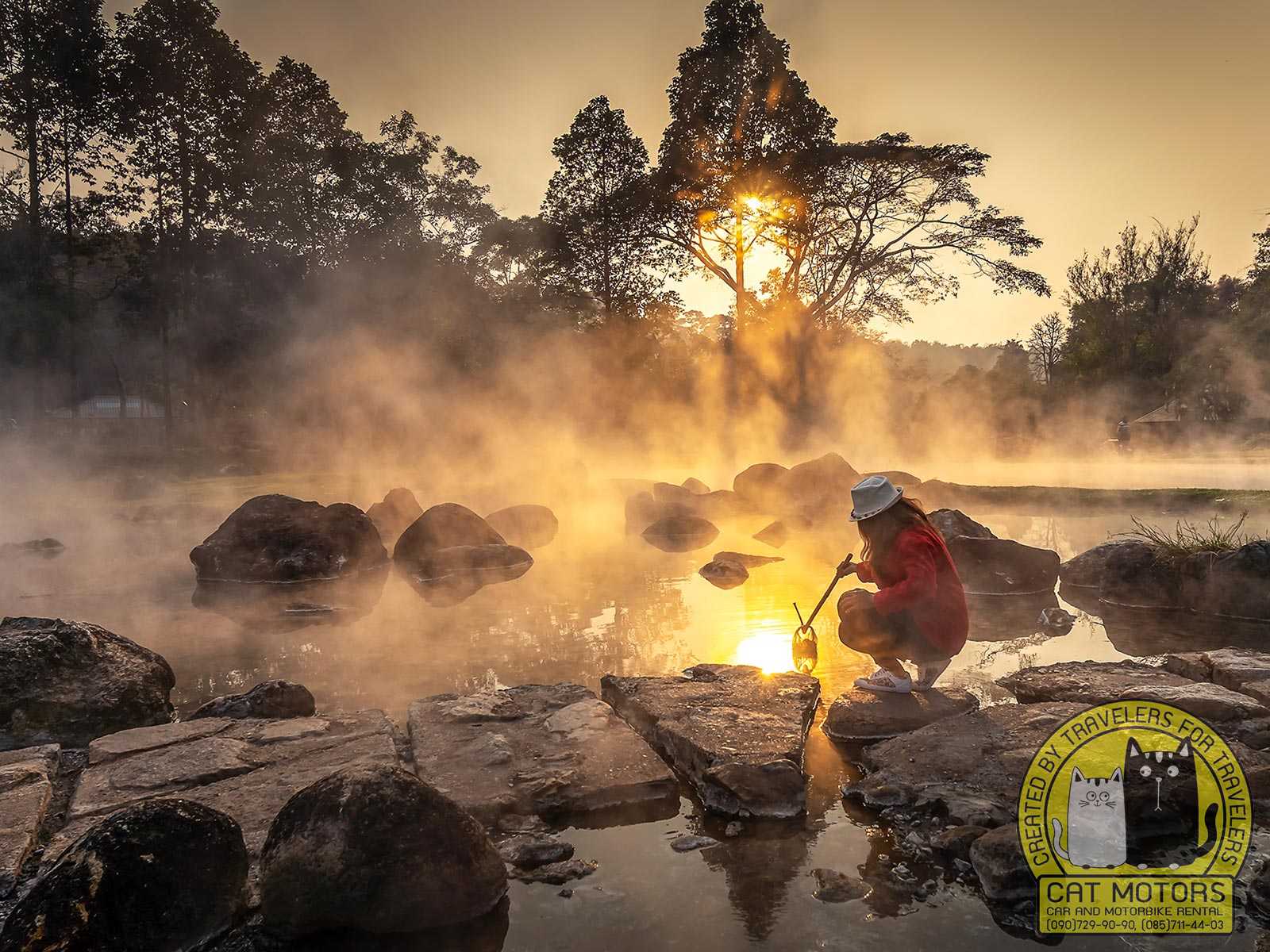
The mineral bath is an onsen in Thai style. You can also request a private onsen bathroom that is surrounded by nature.
Wat Pong Sanuk Nua
Another important old temple in Lampang is Pong Sanuk Nua Temple. It was constructed in 1223 B.E. (680 C.E.), approximately 1,300 years ago. There are Si Chom Khlai Stupa and Phrachao Phan Ong Vihara, also known as 12-Zodiac Vihara, with stunning and ancient architectural features.
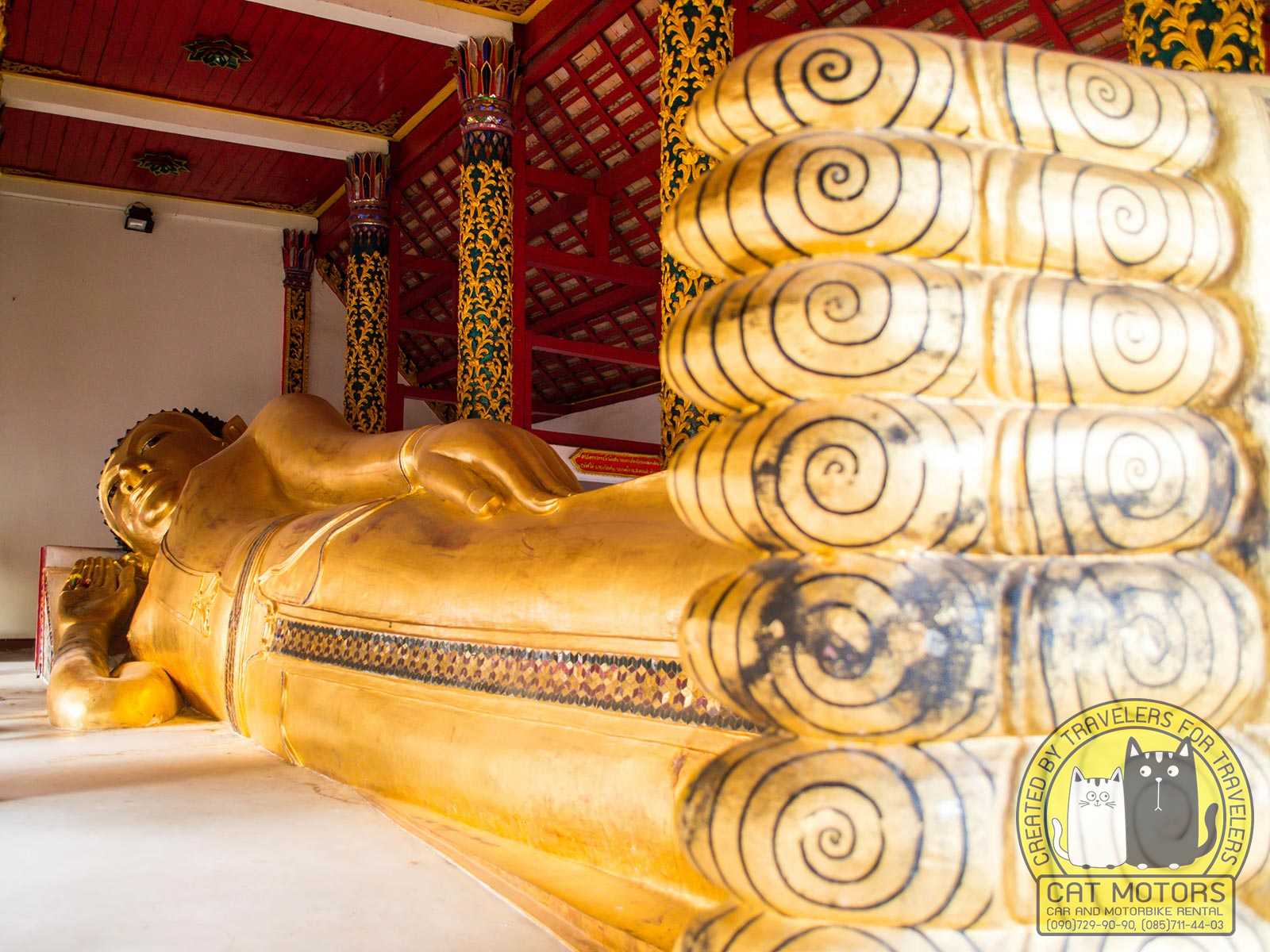
In addition, this temple houses the first city pillar of Khelang Nakhon and a valuable collection of cultural and artistic items. It received the Award of Merit from UNESCO for Cultural Heritage Conservation in Asia-Pacific. This means we must not miss this destination at all costs!
Kad Kong Ta Walking Street
Let’s shop in a vintage atmosphere at Kad Kong Ta Street Market. The street market is held every Saturday and Sunday on Talad Kao Street. Apart from delicious food, local goods, and souvenirs, you will experience the retrospective atmosphere through the buildings along the street.
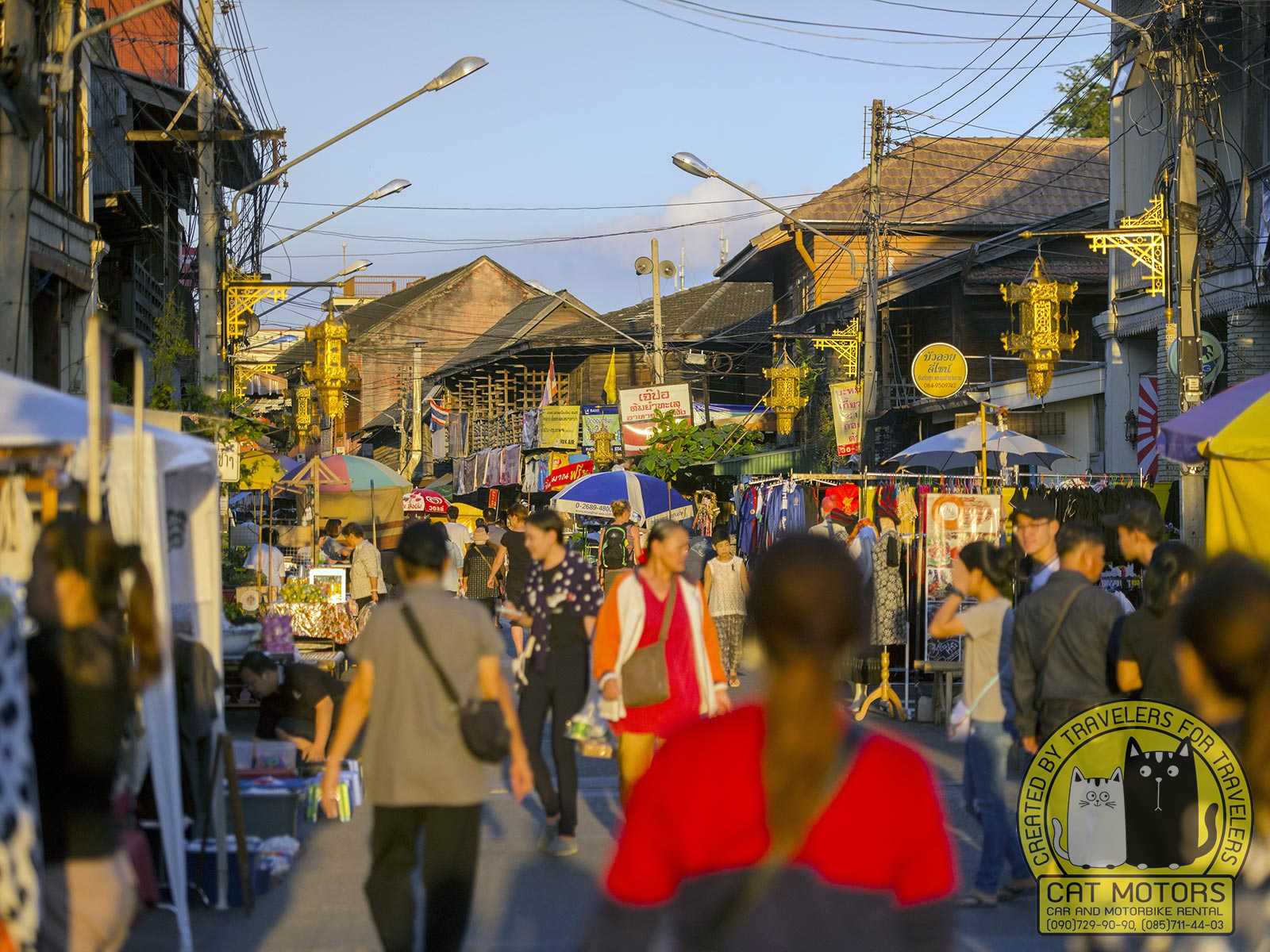
There are various styles of traditional Thai architecture, including central-region style, Lanna, Burmese, Chinese, and French gingerbread-style houses. These architectures date back to when Kat Kong Ta, or Chinese Market, was a market with an essential port for transporting goods and a trading hub of Lampang.
Dhanabadee Ceramic Museum
Aside from horse-drawn carriage, another trademark of Lampang is the rooster bowl. To learn more about the famous rooster bowl, you should visit Dhanabadee Museum.
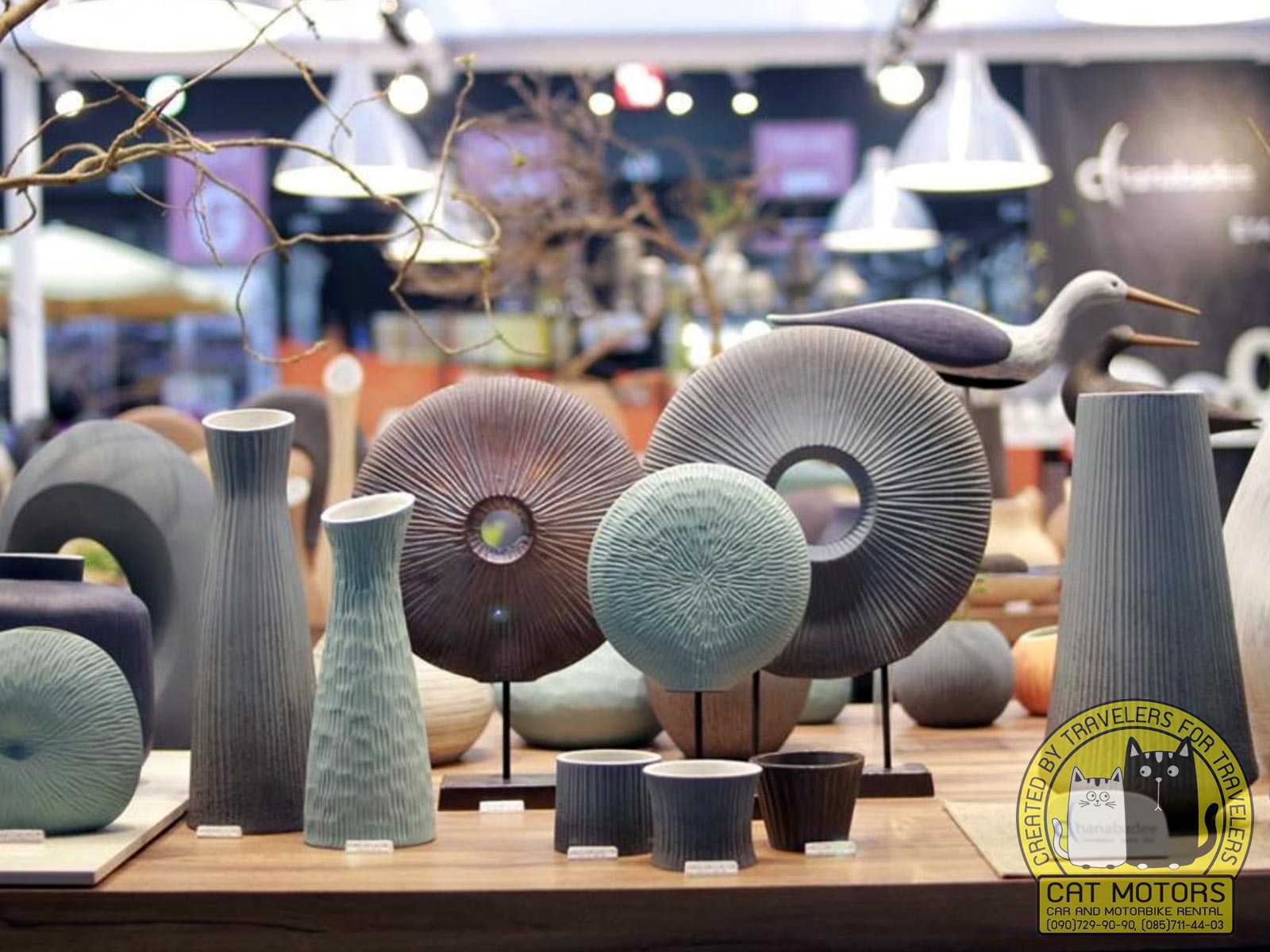
The museum stages an exhibition on the history of ceramics in Lampang and in general. The original production method of the rooster bowls and the smallest rooster bowl are also on display. Then, at the end of your visit, you can purchase high-quality but reasonably priced ceramic products as souvenirs.
Baan Sao Nak
Ban Sao Nak is an old wooden house built in 19th century by a merchant called Mong Chan Ong. The Burmese-Lanna-style ancient teak house is distinguished by its 116 supporting posts.
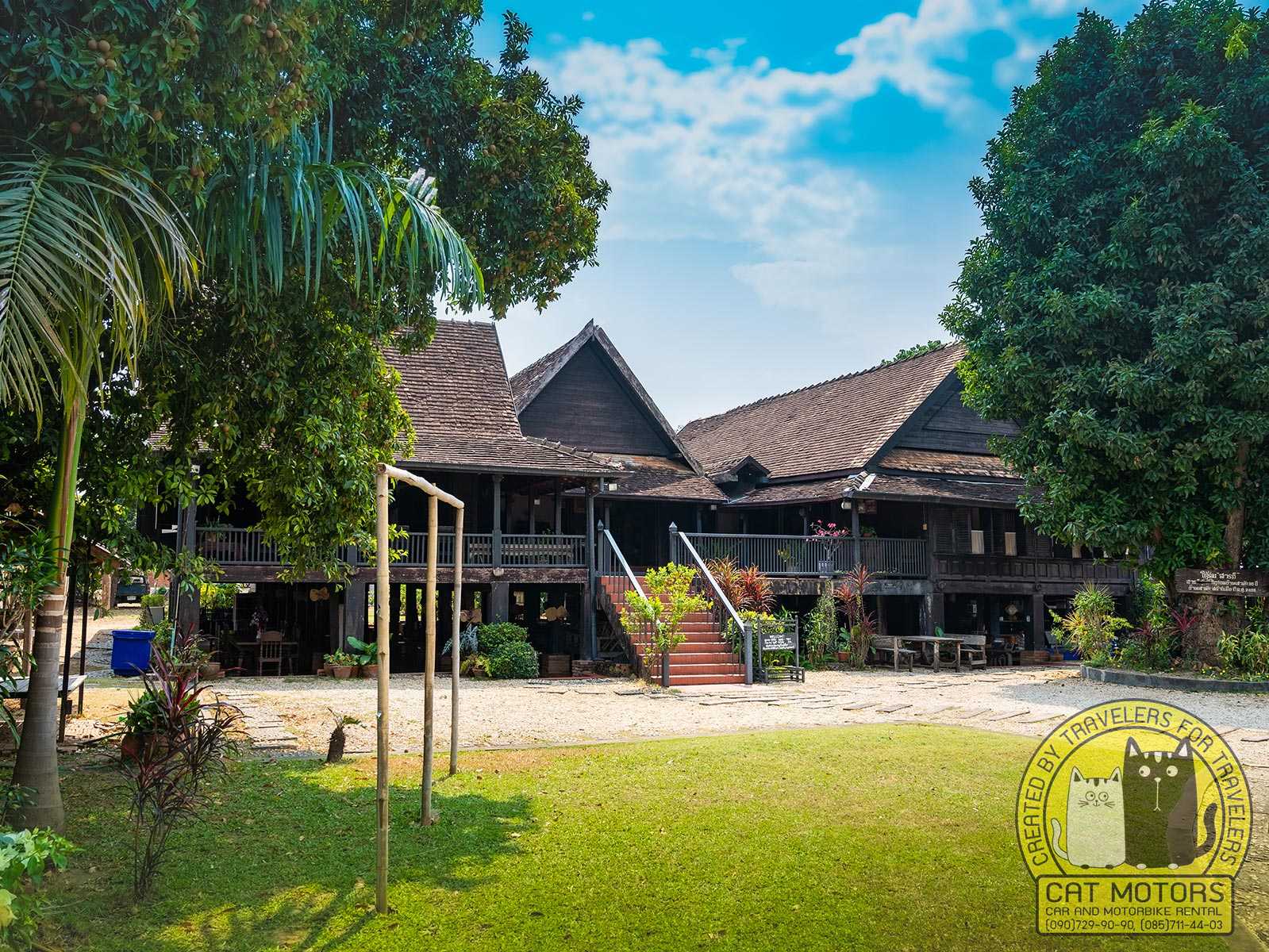
The building was previously used to welcome elite guests and host Khan Tok dinners and auspicious ceremonies. The home is still well-kept and serves as an artistic and cultural museum.
Wat Chaloem Phra Kiat Phrachomklao Rachanusorn (Floating Temple)
Wat Chaloem Phra Kiat Phrachomklao Rachanusorn, also known as Wat Phra Buddha Bhat Phu Pha Daeng, is on the list of must-see Unseen Thailand places. The temple is situated on a high mountain in the non-hunting area of Doi Phra Bhat in Chae Hom District. It is also known among tourists as the Floating Temple or Sky Temple of Lampang.
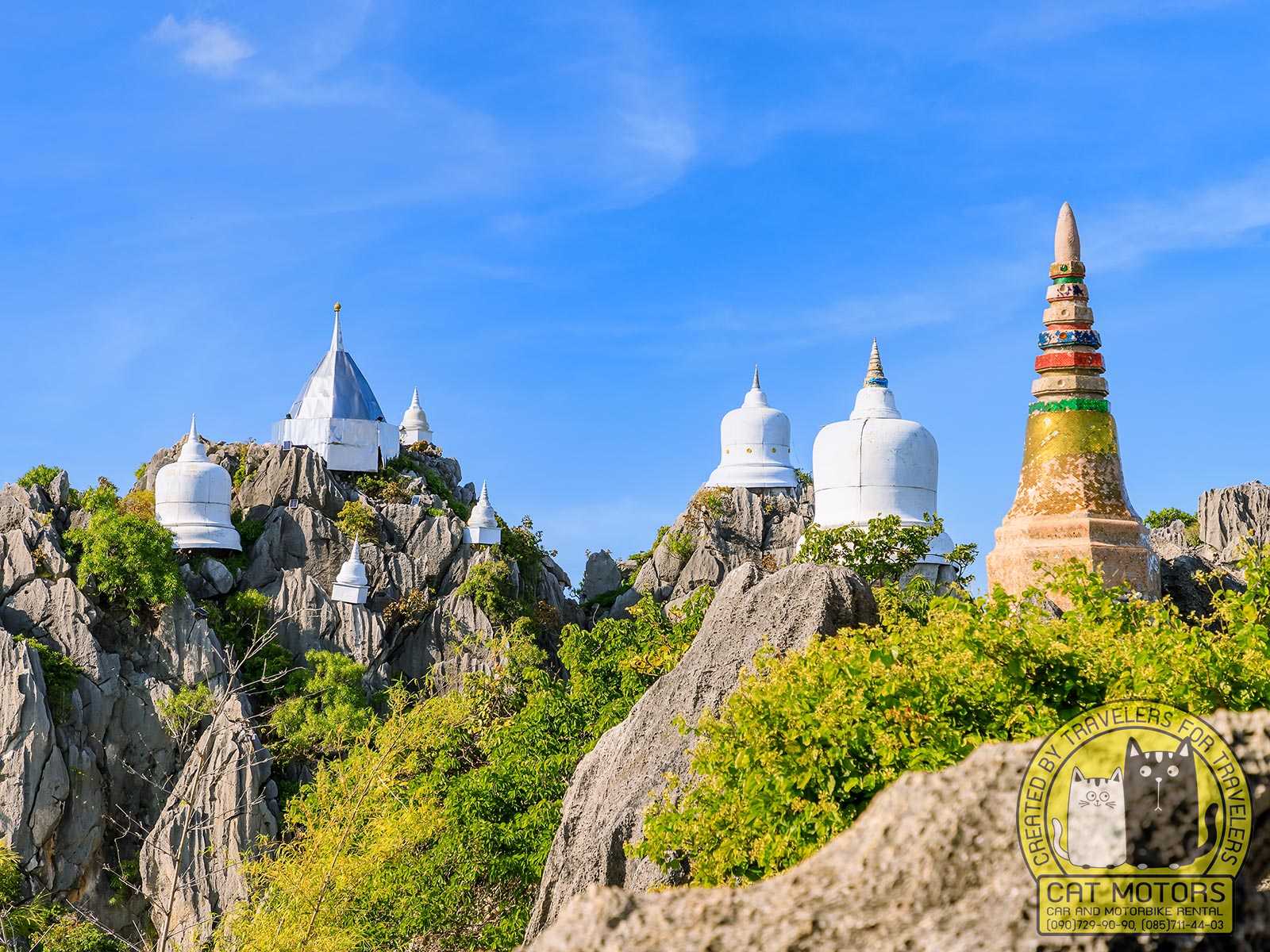
The temple was previously known as Phra Buddha Bhat Phu Pha Daeng because it houses Buddha’s footprint. The highlight here is White Pagoda floating on a beautiful high peak. The temple is divided into three levels. The first level contains ubosot (an ordination hall) and stupas. The Buddha’s footprint is enshrined on the second level. And the top-level treasures, a golden image of the Buddha and white pagoda, stand beautifully and wonderfully on the mountain peak, making this level a breathtaking viewpoint.
Rassadapisek Bridge
Ratsada Bridge (สะพานรัษฎาภิเศก) is also known as Ratsadaphisek Bridge or Khao Bridge. It is another landmark worth photographing. The locals called this bridge many names, such as Kua Si Kong, Kua Luang, and Kua Khao.
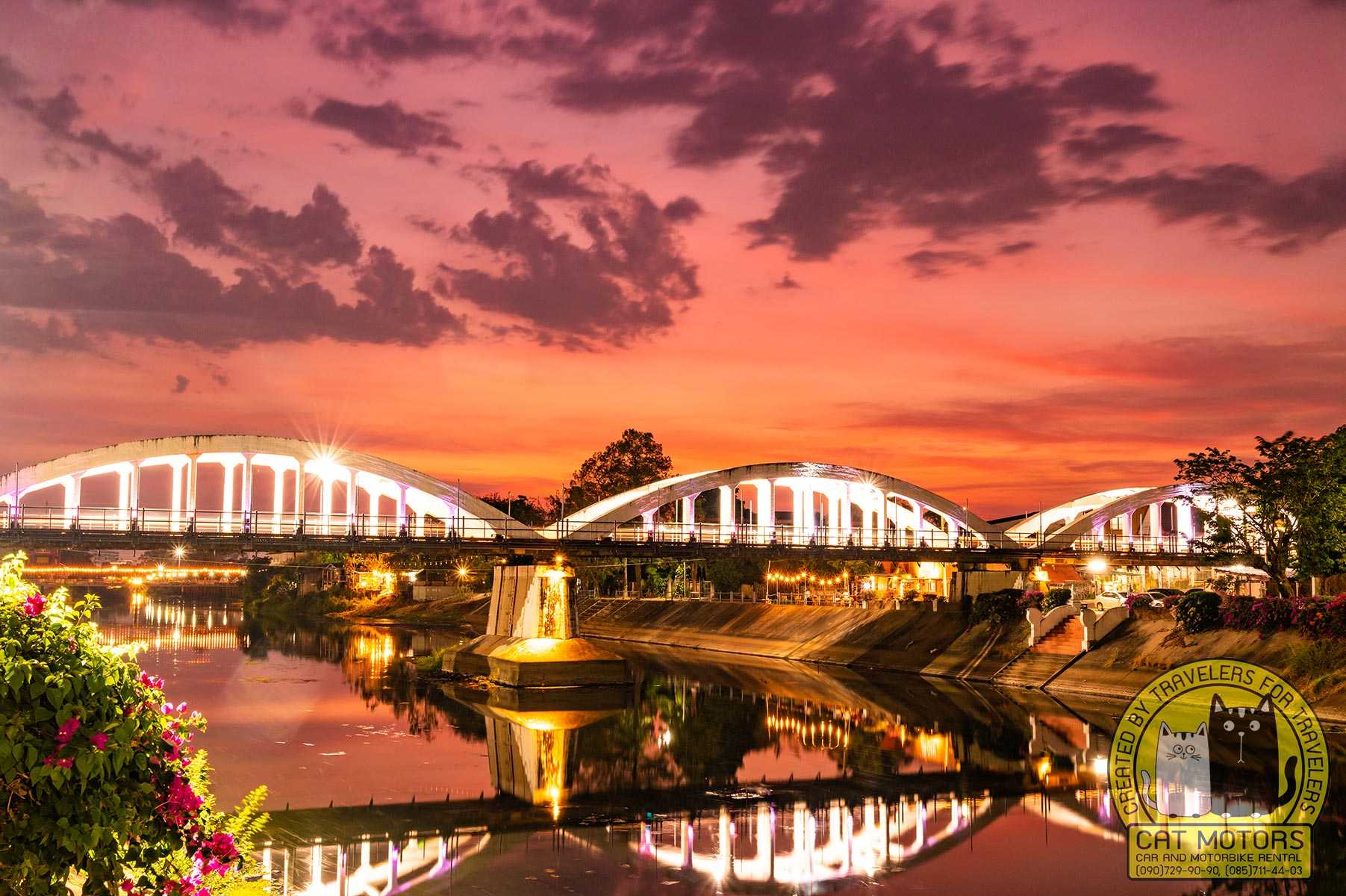
This was originally a wooden bridge built by Prince Noranan Chaichawalit, the ruler of Lampang at that time, in 2437 B.E. (1894 CE) to celebrate King Rama V, so it is over 120 years old. The bridge spans Wang River and marks the beginning of Kat Kong Ta Walking Street. People who visit the city should not miss a chance to take a photograph on this spot.
Nakhon Lampang Railway Station
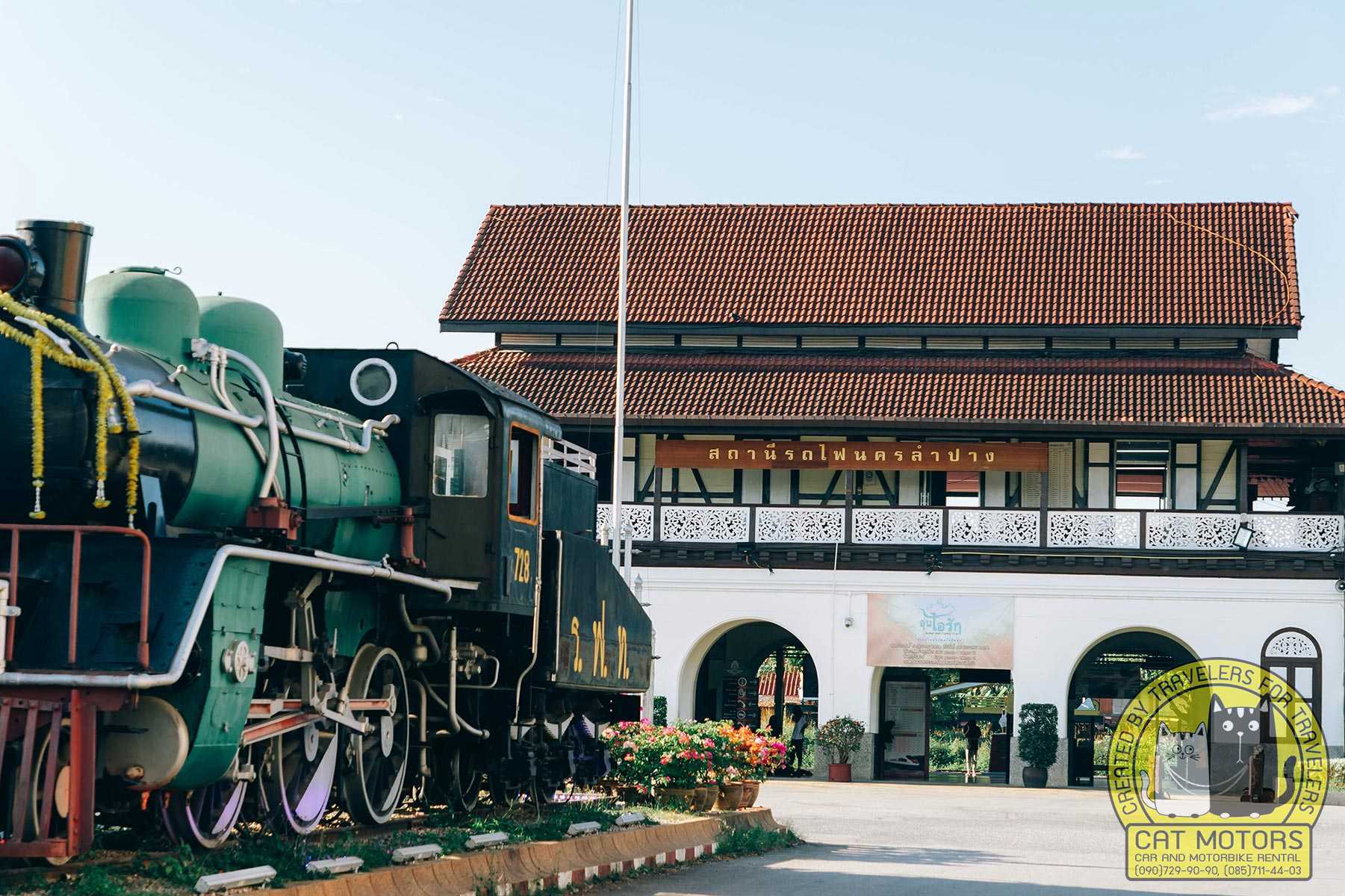
Nakhon Lampang Railway Station is another landmark and lovely spot to photograph. It was built in 2458 B.E. (1915 CE) and featured beautiful architecture, combining Northern Thai and European styles, turning it into a popular photo location for visitors.
Wat Phra Chedi Sao Lang
Phra Chedi Sao Lang Temple is a beautiful temple in the city with a long history, presumably dating back thousands of years. The iconic architecture is a massive main stupa surrounded by another 19 stupas, making up 20 in total. This is also the reason why the temple was named Chedi Sao Lang: sao means twenty.
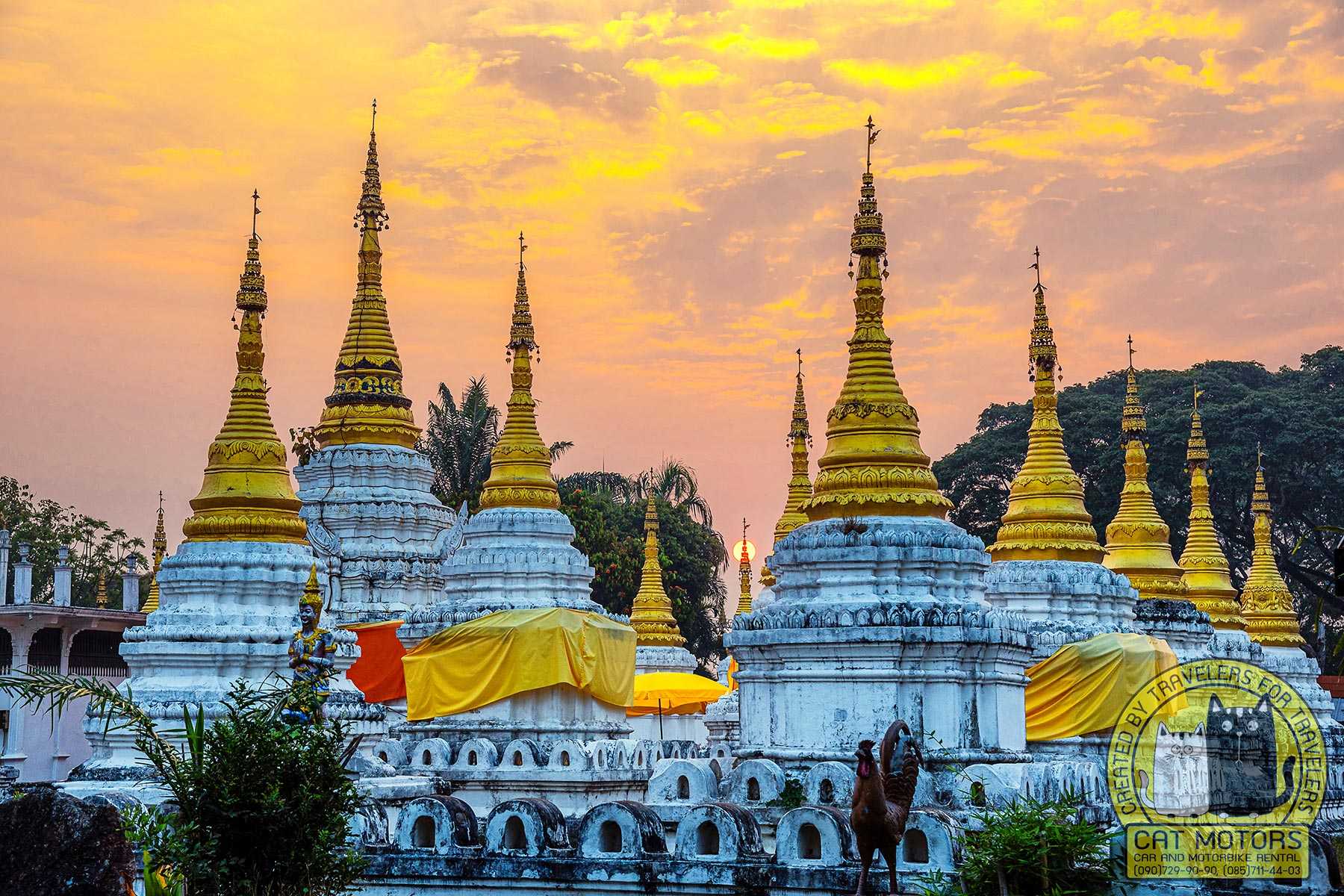
This intriguing sacred place was built in Lanna-Burmese style. Its ordination hall enshrines a buddha statue called Phra Phuttharup Than Chai and a holy beautiful Buddha statue in a subduing evil posture. Besides, a museum displays the ancient artifacts discovered by locals and donated to the temple.
Kao Fu Waterfall
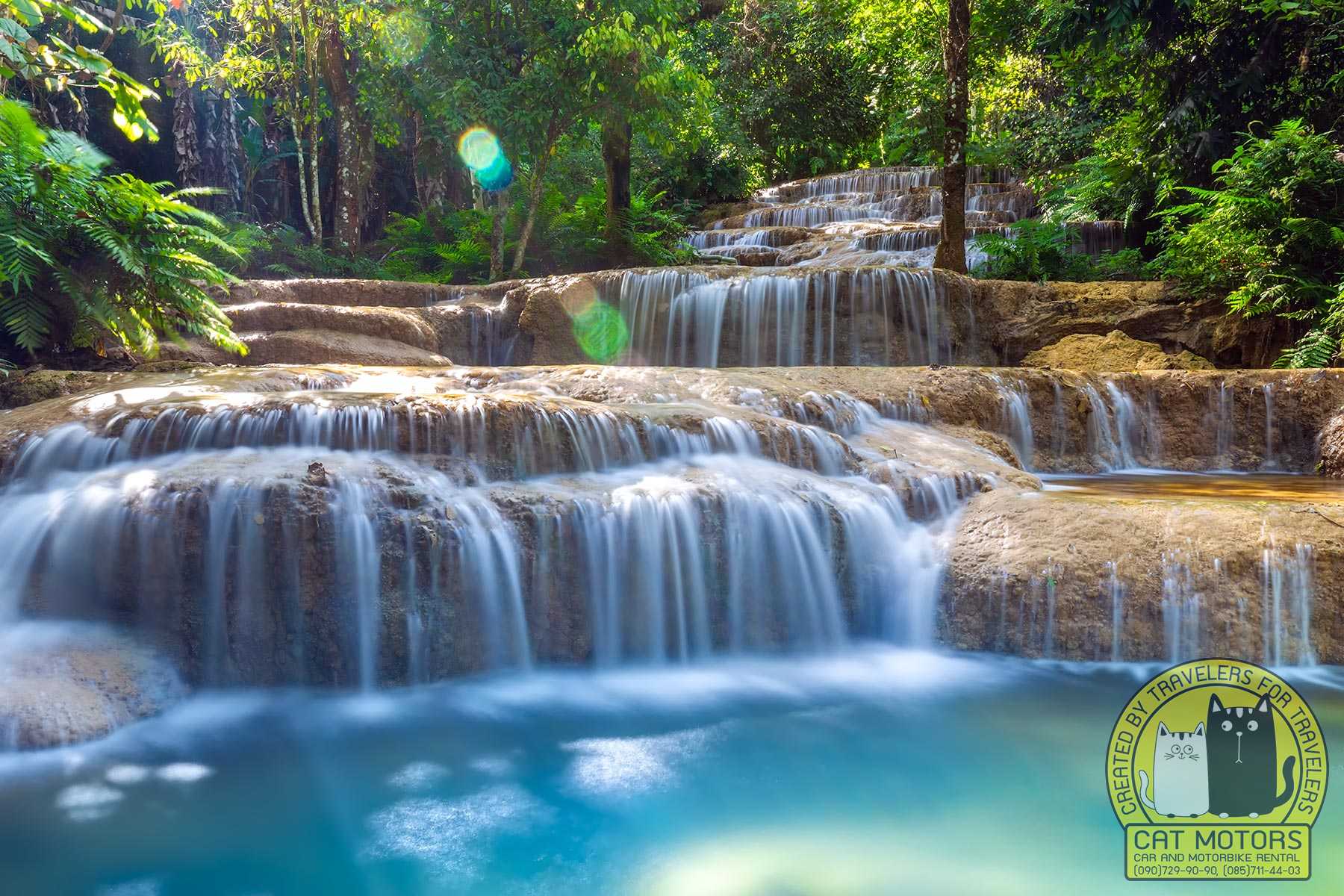
People who love a relaxed trip and ecotourism should not miss the Kao Fu Waterfall in Tham Pha Thai National Park. The artificial waterfall was created by Kao Fu, a hill-tribe Thai, to be an additional water resource in the forest. Later, this location evolved into a natural attraction where tourists can rest and relax.
Kiew Lom Dam
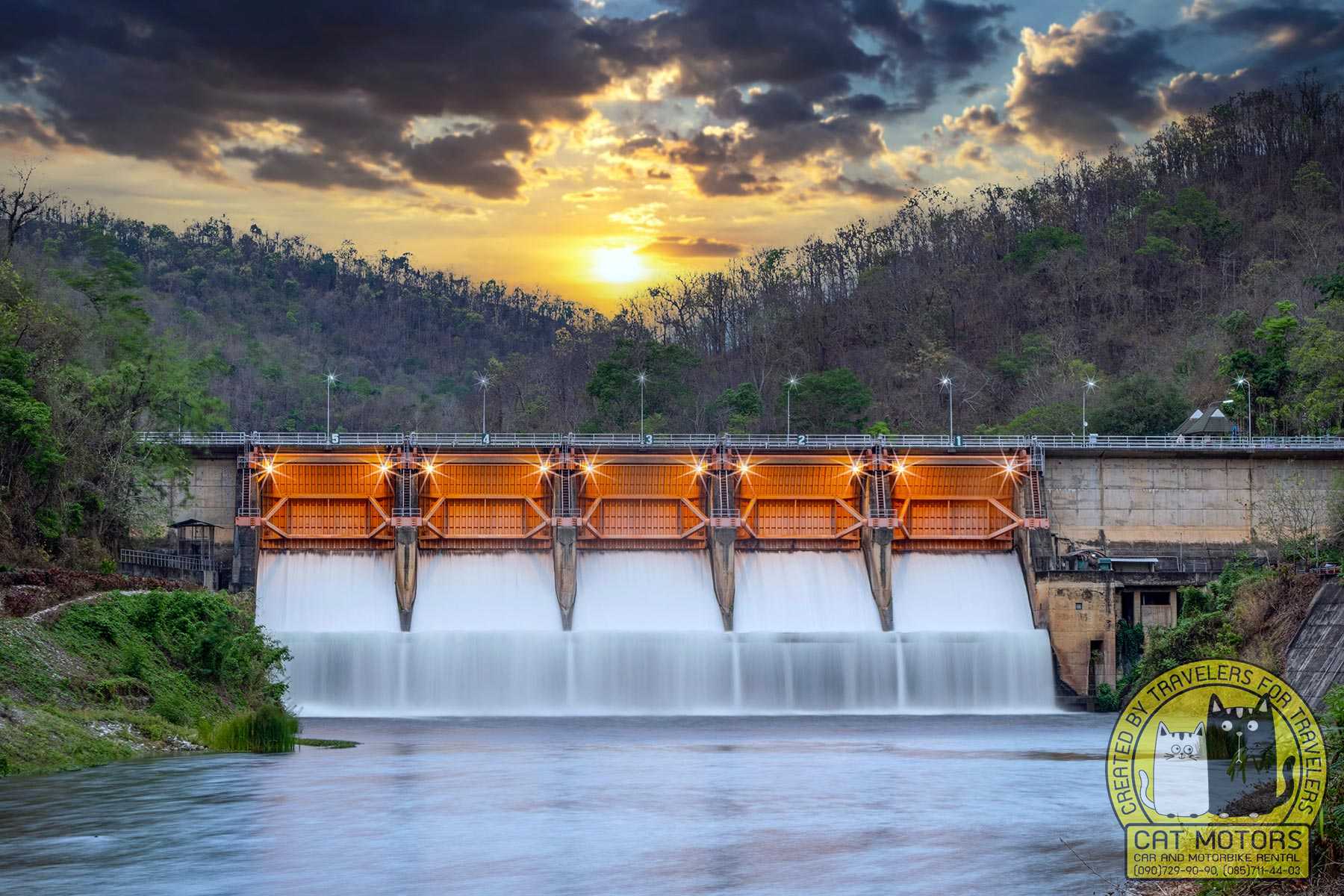
Kiew Lom Dam is a popular destination for the locals. You can raft while taking in the scenery. This is a large reinforced concrete dam used to store water. Due to the nearby mountains and lush forests, tourists love to chill out here.
Wat Phrathat Chom Ping
Phrathat Chom Ping Temple is an old temple purportedly constructed during the reign of Queen Chammathewi (Camadevi) and completed during King Tilokkarat of Lanna Kingdom.
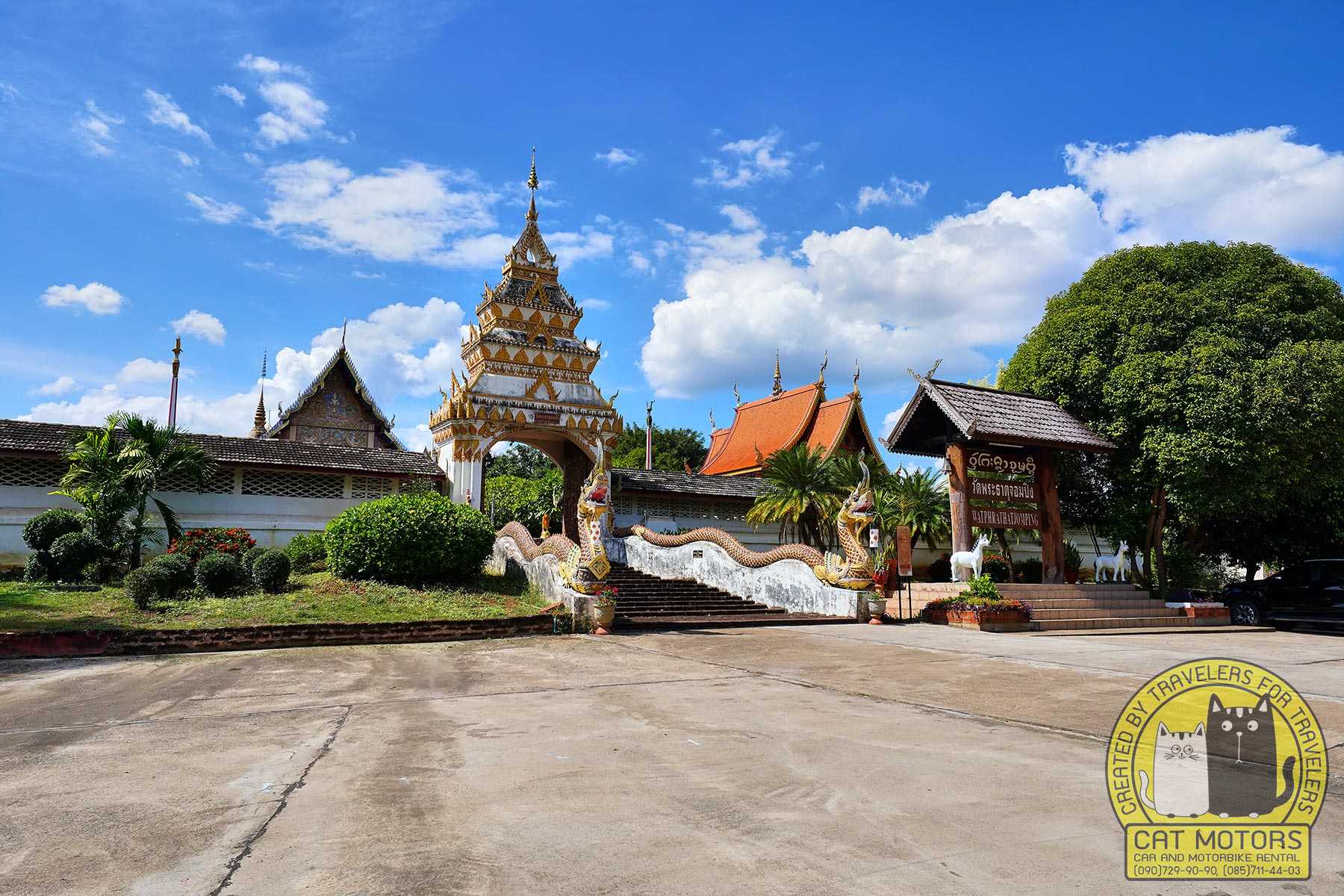
Inside the temple contains Buddha’s relics which Lanna People have revered since ancient times. In addition, its ordination hall enshrines the sacred Phra Buddha Chomping Chaimonkon.
Lom Phu Khiao
Let’s visit a hidden gem of Lampang. Lom Phu Khiao is a large and impressive emerald pool in Tham Pha Thai National Park. The pool was said to have formed when the ground collapsed into a vast crater filled with clear turquoise and emerald water.
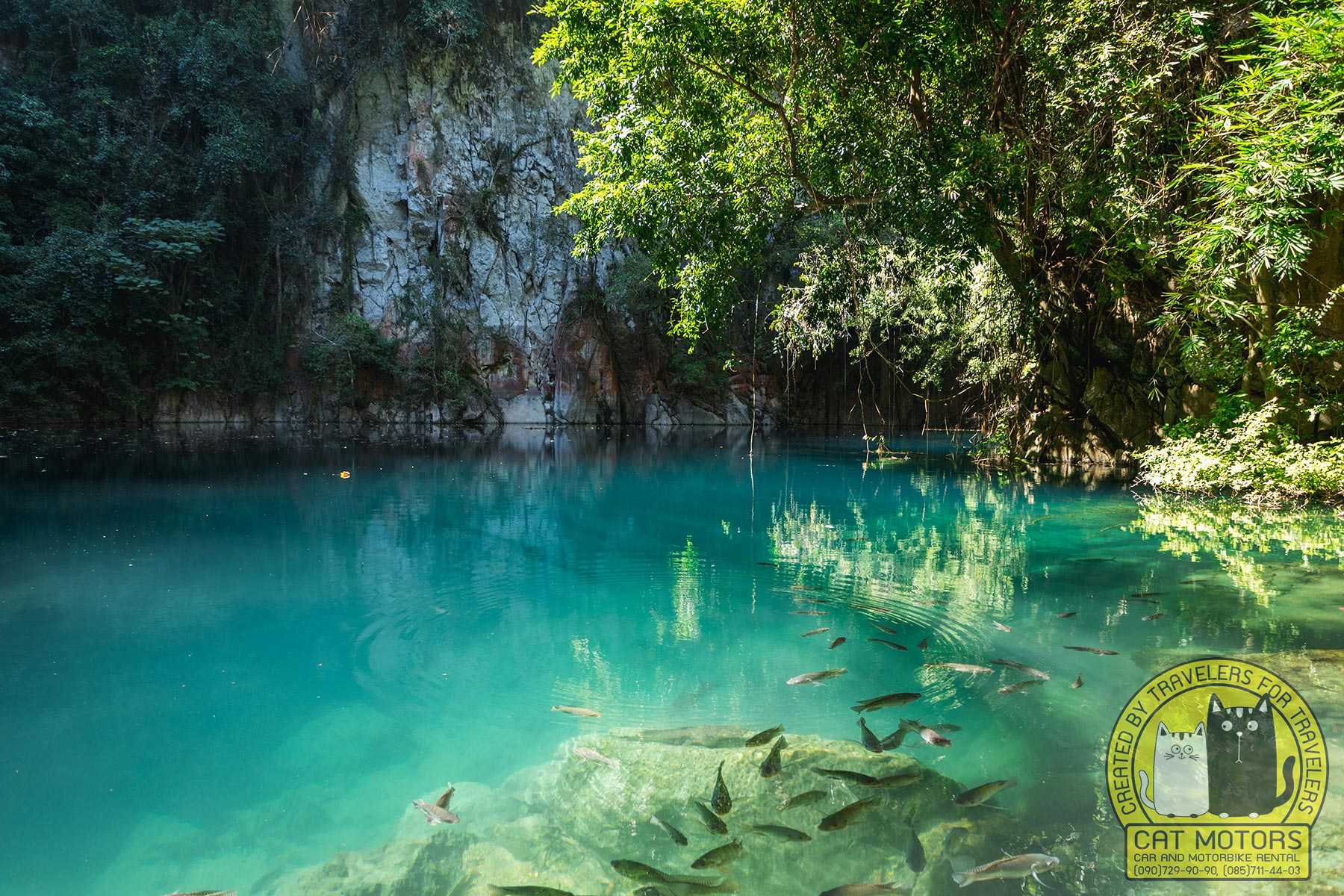
The water is 40 meters deep and has become a habitat for fish. The surrounding areas are limestone mountain cliffs. This is an unseen natural attraction.
Wat Phra Kaew Don Tao Suchadaram
Wat Phra Kaew Don Tao Suchadaram or Phra Kaeo Don Tao Temple is a magnificent, over-1000-year-old temple. It is a significant place because it once housed Phra Kaeo Don Tao, or the Emerald Buddha, for 32 years starting from 1979 B.E. (1436 CE) before the buddha statue was moved to Phrathat Lampang Luang Temple.
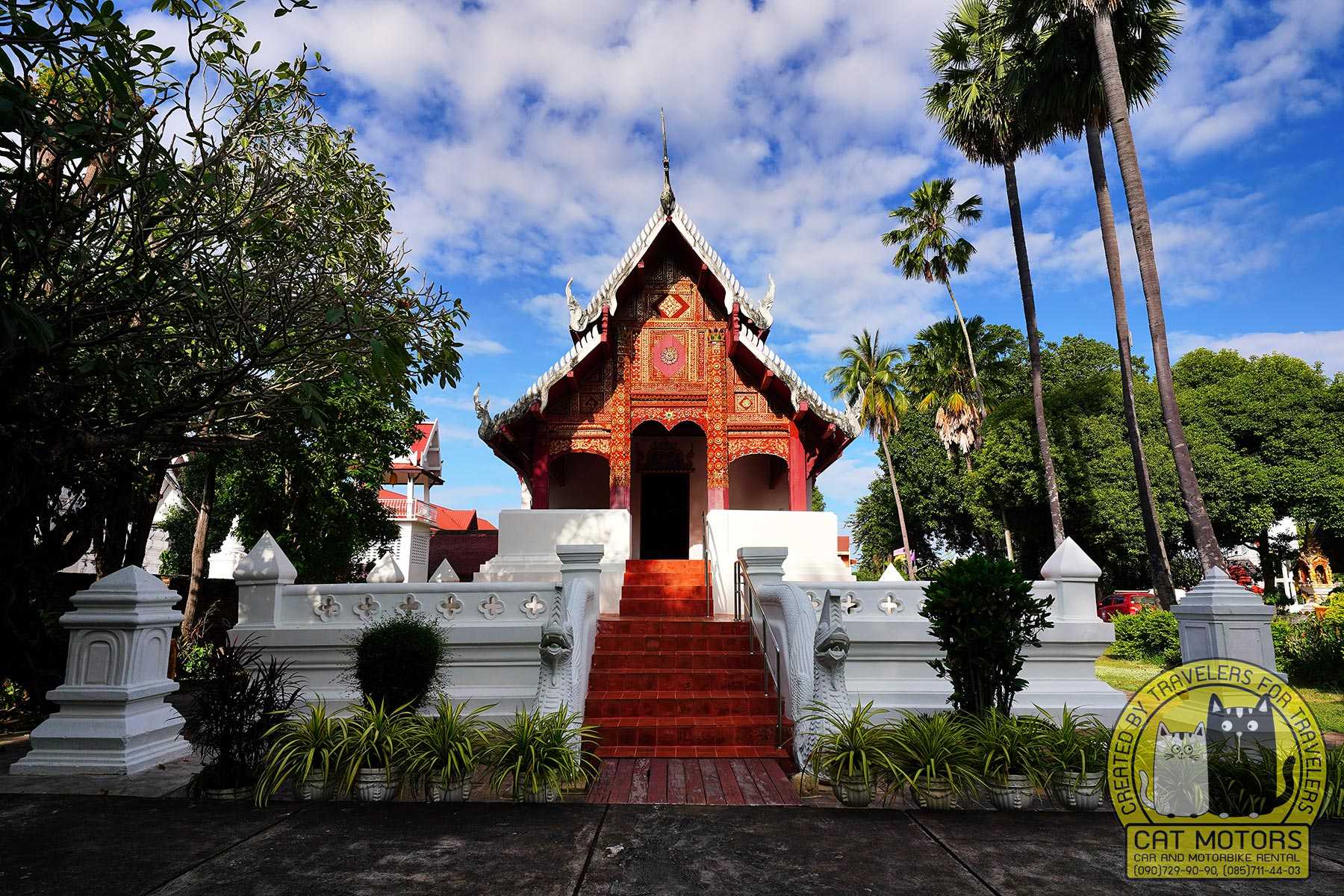
The temple has many sacred objects, including the main massive stupa, which contains Buddha’s hair, a Burmese-style mondop (pavilion) that enshrines an enormous Buddha statue, and a vihara which houses a Buddha statue in a reclining posture that is the same age as the temple. You can also visit Lanna Museum located in the same territory.
Doi Pha Hob
If you want to take the natural scenery leisurely, row a kayak, or sit on a raft, Pha Hob or Doi Pha Hob is an excellent option. This is an incredible natural attraction in Mae Moh District.
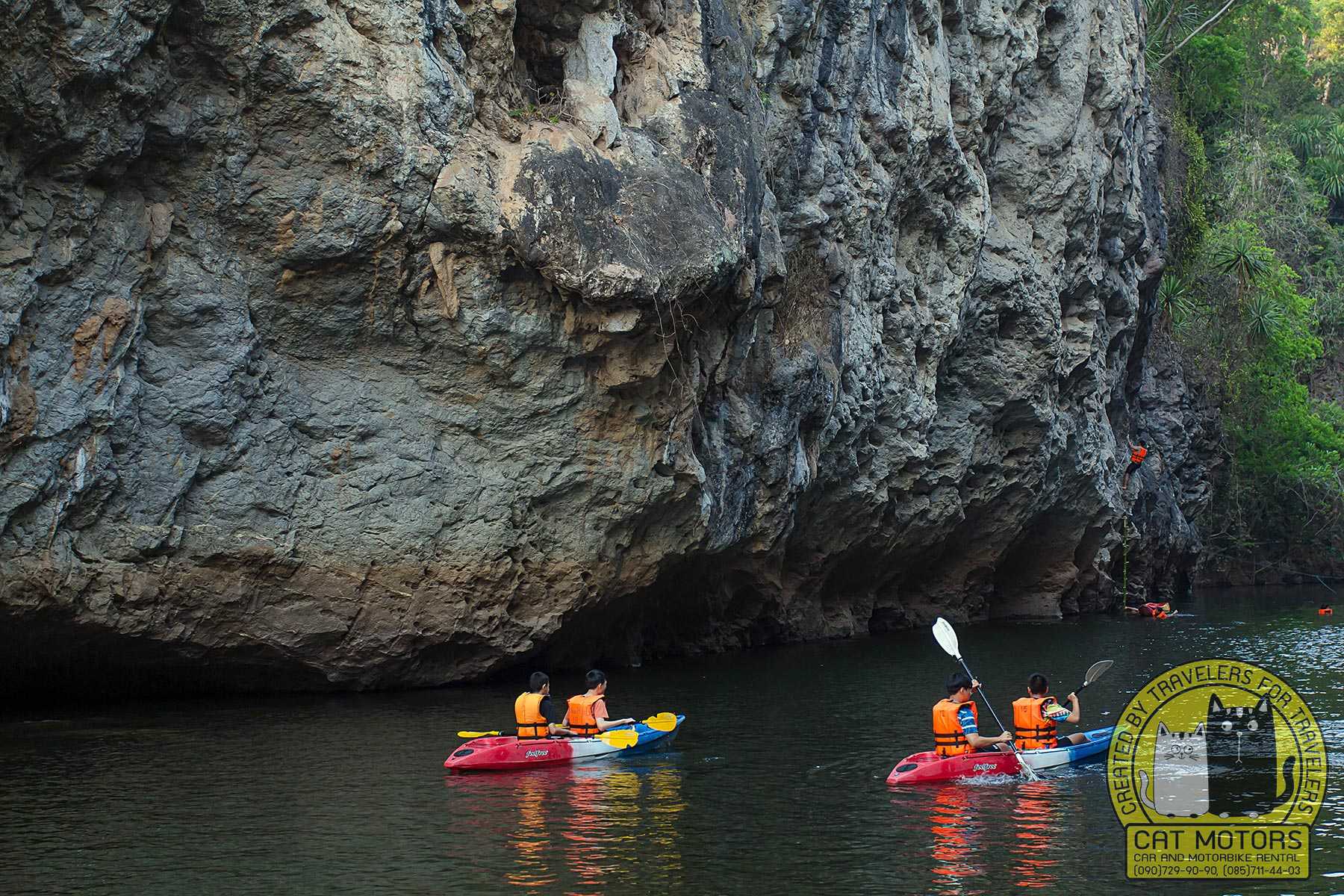
There is a large stream between two cliffs, and you can explore a cave with dazzling stalagmites and stalactites. Then, you can row a kayak amid the beautiful scenery of the cliffs while taking a deep breath of fresh air.
Wat Si Rong Mueang
The original name of Si Rong Mueang Temple is Wat Tha Khra Noi Burma. It was built in 2443 B.E. (1900 CE) by Old Chong Ta Ka In Ta, a wealthy Tai Yai merchant. The temple is well-known for having the most beautiful teakwood vihara in Lampang. It took seven years to build, from 2448-2455 B.E. (1905-1912 CE). The Burmese-style wooden vihara has layered gables and nine finials.
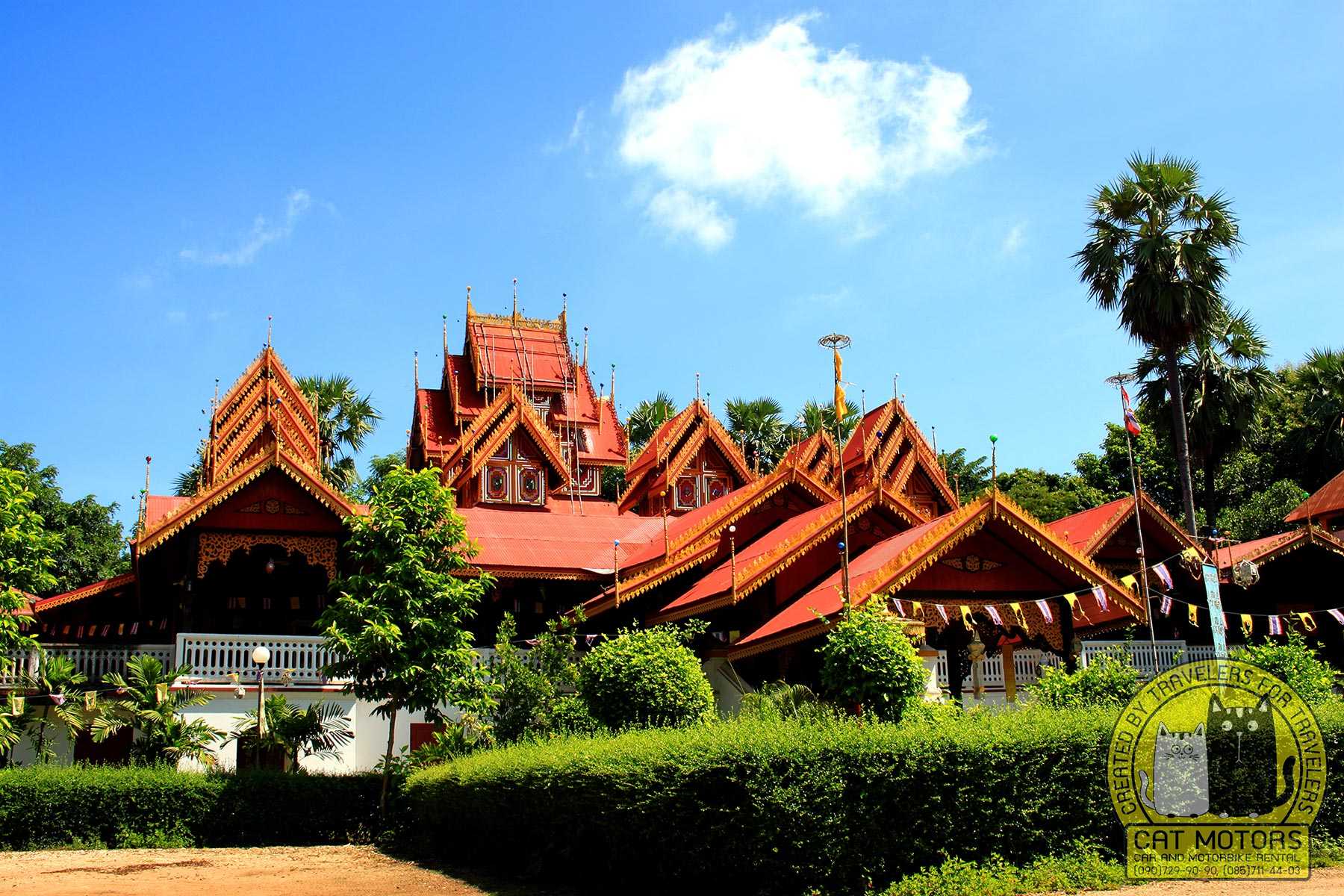
The Burmese art can also be found in other structures, such as every post of this vihara decorated with mosaics and gold design from the base to the top. This is one of the temples worth visiting.
Pong Yang Khok
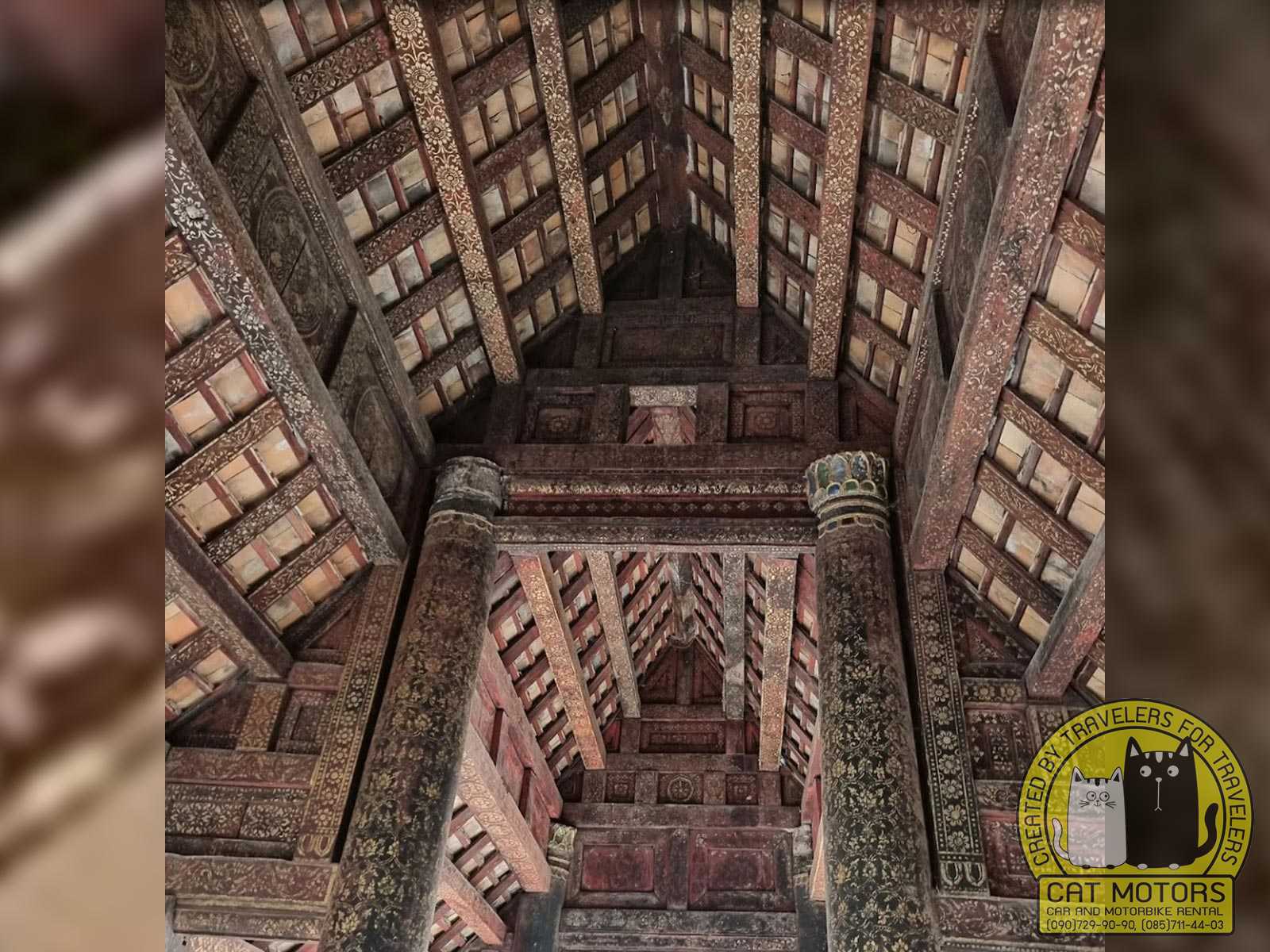
Pong Yang Khok is an old temple with a rich history. It houses Chammathewi Vihara, a beautiful 1300 years old wooden vihara built by Lampang artisans in 13th century of the Buddhist Era. Many aspects of the vihara differ from those of a typical vihara. For example, the crossbeams and the posts were gilded. This vihara enshrines a Buddha statue in a blessing-giving posture. It was designated as a historic site and architecture with significant conservation by The Association of Siamese Architects in 2543 B.E. (2000 CE).
If you’re in Northern Thailand and haven’t decided where to go yet, be sure to check out our list of the most popular things to do in Chiang Mai.
Where to Eat in Lampang
Of course, as in other places in Thailand, you will find many cafes and restaurants in Lampang. However, we recommend that you visit the following sites for lunch or dinner, where your inner gourmet can enjoy the authentic cuisine of this region:
Krua Nuan Hom
Krua Nuan Hom is a beef restaurant. The restaurant’s menu was compiled by Mr. Aod, the highest professional in Thai and Chinese cuisine with more than 30 years of experience. Therefore, each dish tastes genuinely outstanding. Try the beef steak, homemade sausages, roast beef curry, and grilled beef skewers. And don’t forget the fresh tropical fruit salads and ice cream!
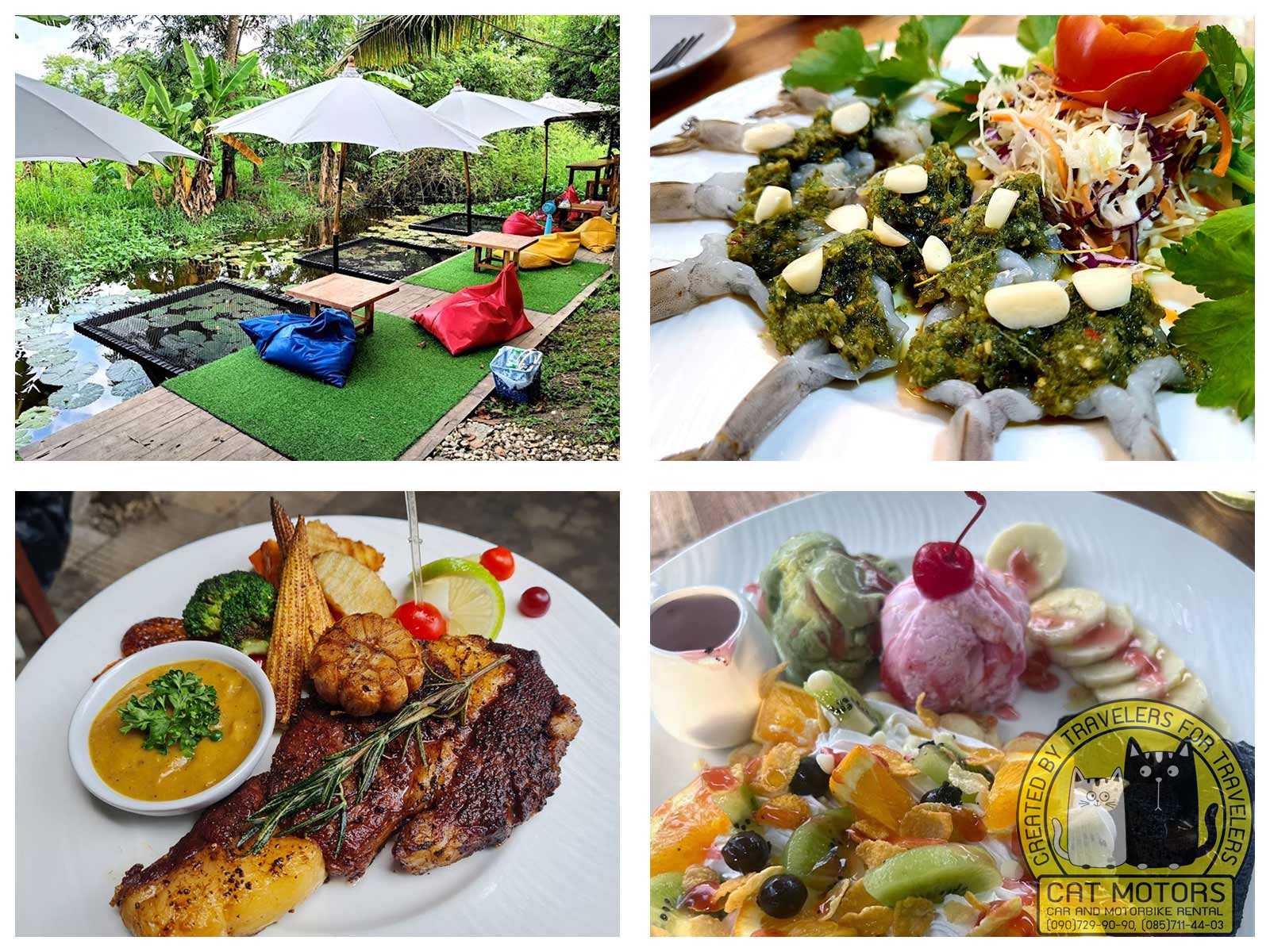
Khao Soi Pha Boon
Khao Soi Pha Boon is a small cafe located in the middle of the village in a private house. The recommended menu at this place is khao soi. Despite the modesty of this establishment, according to many locals, it serves the most delicious khao soi in Lampang. In addition to Khao Soi, you’ll also find traditional rice noodles. At the same time, food prices here are very reasonable. You’ll love it!

Chart Somboon
Chart Somboon is another restaurant with delicious food in Lampang that is popular among locals. The most famous and popular dishes here are Pad Thai with shrimp and Tom Yam with shrimp and cream sauce. There are also many other seafood dishes, including salads, soups, and appetizers.
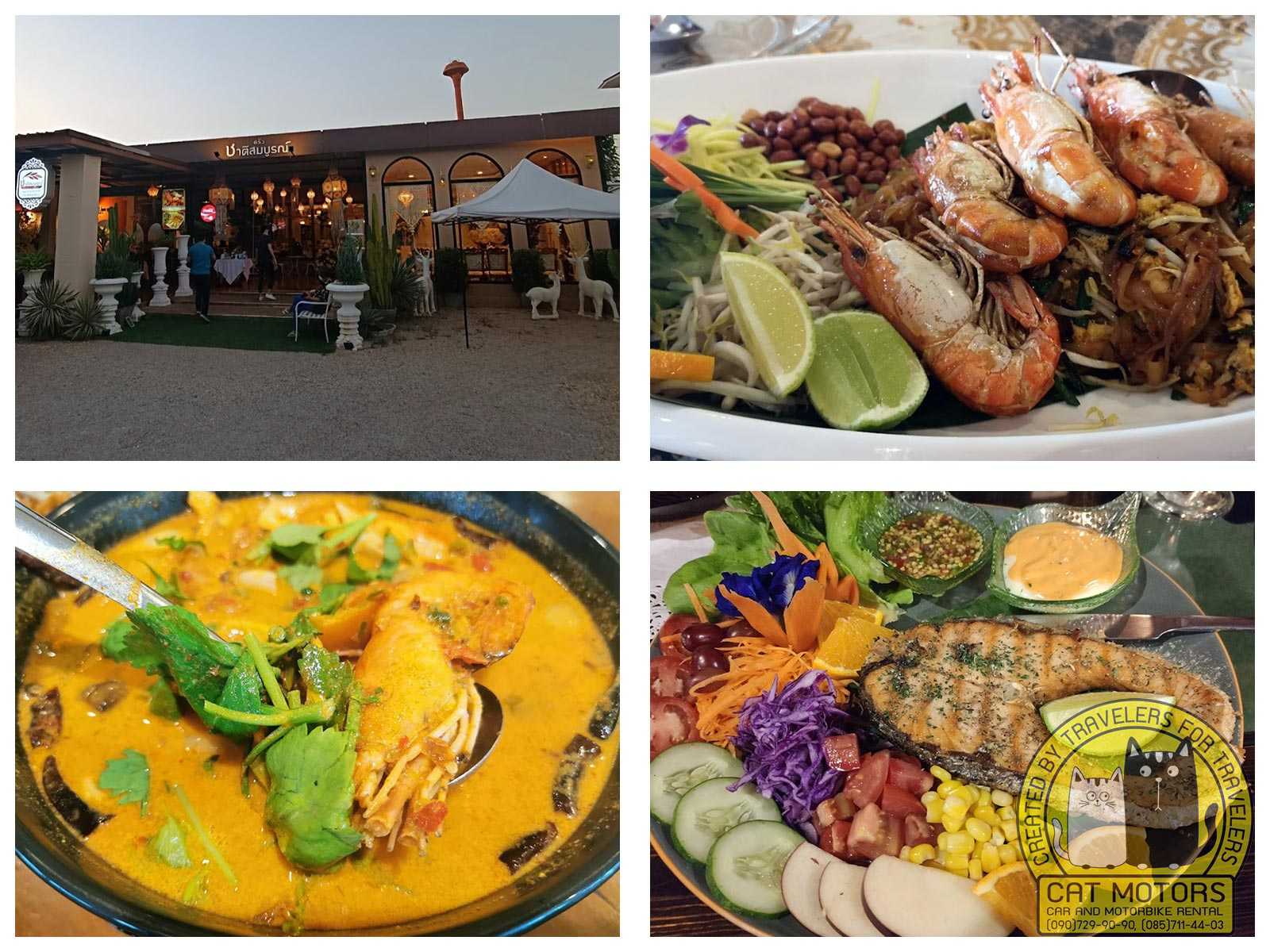
Pang Luang Garden Restaurant
Pang Luang Garden Restaurant – this is a restaurant in Lampang that we recommend to every traveler. In our opinion, it should be the very first local restaurant you should visit. We can even say more – this cafe can be called the gastronomic face of Lampang province, where you will find authentic local food for every taste. We highly recommend tasting Pang Luang’s signature ribs “Three Seasons”. The menu is suitable for both adults and children. The restaurant has a small park where your children will enjoy playing, and you can take some pictures as a memento.
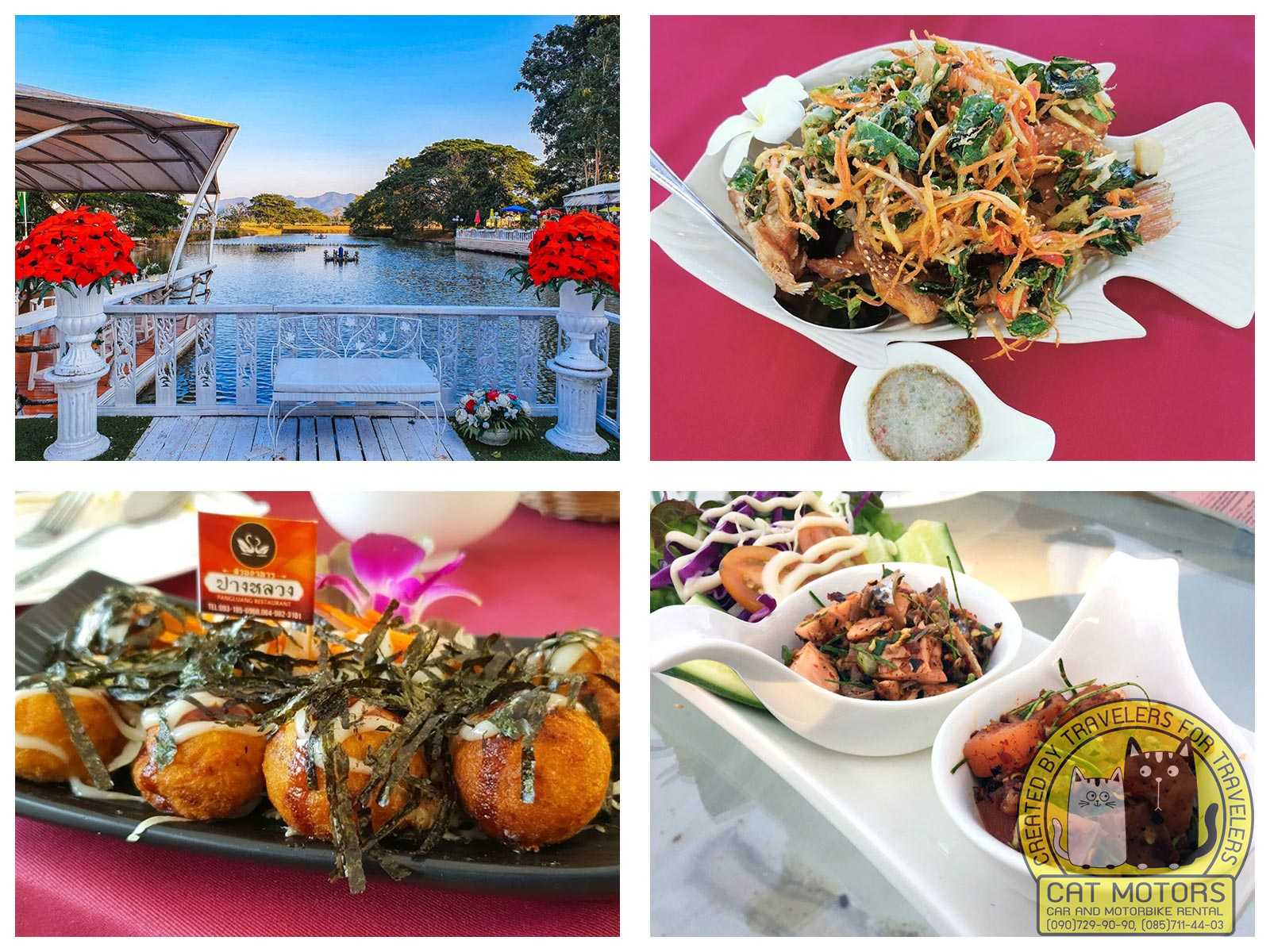
Long Jim’s Pizzeria and Pappa Pizza and Steak is highly recommended if you’re craving traditional fast food.
Weather Forecast
Quick Facts About Lampang
- Geographical Location: Lampang, also known as Nakhon Lampang, is located in the Northern region of Thailand. It lies approximately 600 kilometers north of Bangkok, the capital city of Thailand.
- Provincial Status: It is the capital city of Lampang Province, which is one of Thailand’s 77 provinces.
- Historical Significance: Lampang boasts a rich history dating back to the 7th century. It was a significant city in the Lanna Kingdom, a historical region in Northern Thailand.
- Population: As of my last update, Lampang had a population of around 740,000 in its province, with the city itself accounting for a significant portion of this figure.
- Land Area: The entire province of Lampang covers approximately 12,534 square kilometers.
- Climate: Lampang experiences a tropical savanna climate, characterized by a dry season and a wet season. The temperatures range from about 15°C in winter to 36°C in summer.
- Economic Backbone: The economy of Lampang is primarily driven by agriculture, tourism, and handicrafts, particularly ceramics, which is a distinctive local craft.
- Cultural Heritage: The city is renowned for its horse-drawn carriages and Lanna-style temples, like Wat Phra That Lampang Luang, a notable example of Lanna architecture.
- Natural Attractions: Nearby natural attractions include the Chae Son National Park, known for its hot springs and waterfalls.
- Transportation: Lampang has an airport (Lampang Airport) and is connected to major cities by road and rail. The city is a stop on the Northern Line of the State Railway of Thailand.
- Local Cuisine: Lampang is famous for its local dishes, including Kao Soi (curry noodles) and Miang Kham (a traditional snack).
- Festivals and Events: The city hosts various cultural events and festivals, notably the Songkran Festival and the Lampang Ceramic Fair.
- Historical Sites: Notable historical sites include the Lampang Cultural Street and the Ban Sao Nak, an old teakwood house displaying Lanna architecture.
- Wildlife Conservation: The Thai Elephant Conservation Center, an important elephant sanctuary, is located in Lampang.
- UNESCO Site: The city is part of the UNESCO Creative Cities Network in the field of Crafts and Folk Art.
Travel Tips
Before You Go
- Travel Documents: Ensure your passport is valid for at least six months beyond your stay. Check if you need a visa for Thailand based on your nationality.
- Health Precautions: Consult a travel health clinic for recommended vaccinations. Mosquito repellent is essential to protect against mosquito-borne diseases.
- Local Currency: The Thai Baht (THB) is the local currency. Carry some cash for smaller establishments and rural areas.
- Language Preparedness: While English is spoken in tourist areas, learning basic Thai phrases can be immensely helpful and appreciated by locals.
- Cultural Research: Understanding Thai customs, such as the wai greeting and removing shoes before entering temples and homes, shows respect for local traditions.
Getting There and Around
- Air Travel: Lampang Airport is well-connected with domestic flights, particularly from Bangkok.
- Rail and Road: The city is accessible by train from Bangkok and other major cities. Buses are also viable options.
- Local Transportation: Explore the city via tuk-tuks, songthaews (shared taxis), and the unique horse-drawn carriages.
Accommodations
- Range of Options: Lampang offers a variety of accommodations, from budget guesthouses to boutique hotels. Staying in a traditional Lanna-style hotel can enhance your cultural experience.
- Advance Booking: During festivals and peak tourist seasons, book your accommodation in advance.
Food and Dining
- Local Cuisine: Don’t miss Lampang’s famous dishes like Kao Soi and local street food markets. Be cautious with street food if you have a sensitive stomach.
- Dining Etiquette: Remember, it’s customary to use a fork and spoon for most Thai dishes.
Sightseeing
- Temples and Historical Sites: Visit Wat Phra That Lampang Luang, Ban Sao Nak, and the Lampang Cultural Street for a glimpse into Lampang’s rich heritage.
- Nature Escapes: Spend a day at the Chae Son National Park for its hot springs and scenic hikes.
- Elephant Conservation Center: A visit to the Thai Elephant Conservation Center is a must for wildlife enthusiasts.
Shopping
- Local Crafts: Explore the local markets for ceramics, traditional handicrafts, and souvenirs.
- Bargaining: While bargaining is common in markets, do it respectfully.
Festivals and Events
Khantok Chang Fair (February): Held at the Thai Elephant Conservation Centre, this fair celebrates elephants with shows and a traditional Lanna banquet. It’s a fusion of elephant appreciation and cultural feasting.
City Pillar Worship Ceremony (February): At the Lampang Provincial Hall, this ceremony combines Buddhist and Brahmin rituals, including local dance performances to bring good luck to the city.
Dok Siew Blossom Festival (February): Set in Pa Miang Village, this festival showcases local traditions, OTOP products, and nature conservation tourism, with guides educating visitors about ecotourism.
Fish Eating Fair (March): Located at the Park at Clock Tower 5 Aces, this festival includes fish exhibitions, contests, and a variety of fish-based culinary delights.
Lanna Style Wedding on Elephant-Back (March): At the Thai Elephant Conservation Center, this unique event offers couples the chance to marry on elephant-back, parading through Lampang’s historic streets.
Rachadaphisek Bridge Memorial (19th – 26th March): This event honors the iconic bridge’s history, with participants dressed in early 20th-century attire.
Songkran Festival at Pa Sang (Date Varies): A traditional Lanna and Thai New Year festival featuring drum and dance competitions.
Lampang Trains and Horse Carriages Day (Beginning of April): Celebrated at Lampang Main Railway Station, this festival commemorates the history of trains and horse carriages in Lampang with various cultural performances.
Klong Bu Ja Festival (April): Held in Ke-lang-nakorn Park, this event focuses on Lanna musical traditions, especially drum and string instrument competitions.
Pineapple Fair (June): At Amphoe Mueang, this fair features a Giant Pineapple Competition, a beauty contest, and various pineapple-based products.
Mae Moh Walking Rally and Mini Half Marathon (August): A healthy and scenic marathon event held at Mae Moh Lignite coal mine, emphasizing both fitness and stunning local views.
Luang Wiang Lakhon Fair (November): Taking place at Wat Pra Kaew Don Tao and Wat Phra That Lampang Luang, this fair highlights the history and traditions of Lampang with unique parades and alms offerings.
Long Sa Bao Jao Wiang La Korn Festival (November): Celebrated at Wat Phra That Lampang Luang, this festival includes a rocket festival, drum beating contest, and Lanna style dinners.
Lampang Ceramic Fair (First Friday of December): A 10-day event at the 4th Municipal Market featuring a wide range of ceramics, cultural processions, and local food.
Winter and Red Cross Fair (December): Held at the Lampang Provincial Stadium, this festival offers a wide variety of products, shows, and performances, including the Miss Lampang Contest.
Safety and Etiquette
- Respect Local Customs: Dress modestly, especially when visiting temples. Avoid touching people’s heads and pointing your feet at people or religious objects.
- Safety Measures: Stay aware of your belongings in crowded areas. Use authorized transportation services.
Connectivity
- Internet Access: Wi-Fi is widely available in hotels and cafes. Consider a local SIM card for longer stays.
Health Services
- Local Hospitals: Know the location of nearby hospitals or clinics. Travel insurance that covers medical emergencies is highly recommended.
Pros & Cons for Travel to Lampang
Pros
- Cultural Richness: Lampang is steeped in history and culture, particularly known for its Lanna heritage. The city’s temples, traditional houses, and cultural sites provide an authentic Thai experience.
- Unique Transportation: The charm of horse-drawn carriages offers a unique way to explore the city, setting Lampang apart from other Thai destinations.
- Natural Beauty: The province is home to stunning natural landscapes, including national parks like Chae Son, known for its hot springs and waterfalls.
- Elephant Conservation: The Thai Elephant Conservation Center is a highlight for animal lovers and those interested in wildlife preservation.
- Crafts and Ceramics: Lampang is renowned for its ceramics and pottery, offering unique souvenirs and insights into local craftsmanship.
- Less Touristy: Compared to bustling tourist hubs like Bangkok or Chiang Mai, Lampang offers a more relaxed and authentic atmosphere, ideal for those seeking a quieter travel experience.
- Affordability: Expenses in Lampang, from accommodation to food, tend to be more affordable compared to Thailand’s more popular tourist destinations.
- Local Cuisine: The city offers an array of delicious local Thai dishes that are both flavorful and unique to the region.
Cons
- Limited English: English proficiency is not as widespread compared to larger tourist destinations, which might pose a communication challenge for some travelers.
- Transport Connectivity: While Lampang is accessible, it’s not as well-connected as major cities. Travelers might need to navigate local transportation modes, which can be a bit daunting.
- Fewer Western Comforts: Those accustomed to Western-style amenities might find Lampang a bit lacking in this regard, as it maintains a more traditional Thai setting.
- Limited Nightlife: If you’re looking for vibrant nightlife, Lampang is more subdued compared to Thailand’s beach destinations or Bangkok.
- Seasonal Weather: Travelers should be mindful of the seasonal weather, especially the hot summers and the monsoon season, which might affect outdoor activities.
- Medical Facilities: While there are medical facilities, they may not be as comprehensive as those in larger cities, which is a consideration for those with health concerns.
- Tourist Information: There might be fewer resources and tourist information centers compared to more tourist-centric locations.
Conclusion
Lampang offers a charming and culturally rich experience for travelers seeking an authentic Thai experience away from the crowded tourist circuits. However, its less touristy nature means fewer amenities and conveniences that some travelers might expect. This destination is ideal for those who wish to immerse themselves in traditional Thai culture and nature, and who are comfortable navigating a region with less reliance on typical tourist infrastructure.
Video Review
First Impressions of Lampang
I Climbed the Sky Temple
24 Hour Northern Thailand Road Trip to Lampang
FAQ
There are several ways to get from Chiang Mai to Lampang. First of all, by renting a motorcycle in Chiang Mai with our company. If you need a chauffeur-driven car, you can hire a private minibus with a driver for just a couple thousand baht.
You can also take a public bus to Lampang. It will only cost you 110 baht, but it is not a very convenient way to travel since most of the attractions of Lampang are outside the city and you will, in any case, need either private transport or a car with a driver.
Lampang city is located in northern Thailand, about 100 kilometers and an hour and a half drive from Chiang Mai. The trip from Bangkok takes about 10 hours if you drive your car.
Of course! Lampang is worth a visit! It is a beautiful city with a centuries-old history, rich cultural heritage, and many exciting sights. It is also home to some of the most famous temples in Thailand, such as Wat Phra That Lampang Luang and Wat Phra Kaew Don Tao.
Lampang is known for its traditional architecture, its beautiful temples, and its unique culture. It is also known for its delicious cuisine, its vibrant nightlife, and its friendly locals. Additionally, Lampang is known for its natural beauty, with lush forests, rolling hills, and stunning waterfalls. Moreover, it was with the armed rebellion in Lampang hundreds of years ago that the liberation of the Kingdom of Lanna from the Burmese invaders began.
The best time to visit Lampang is from November to February when the weather is cooler and more comfortable. Unfortunately, this is also the peak tourist season when many local and foreign tourists come to the city, so you may have some difficulty booking hotels.
You can easily spend two or three days in Lampang, depending on what you want to do and see. If you explore the city and surroundings, you might want to stay for a week or more. If you are limited to one day, your trip will be exciting and enjoyable either way.
The coldest month in Lampang is January, when temperatures can drop as low as 10°C (50°F). Of course, for residents of Europe or the U.S., this is not too cold weather, but for residents of Thailand, where year-round temperatures stay at 35-38 degrees Celsius, 10 degrees warm is unusual. This is why the northern regions of Thailand, including Lampang, are so popular with locals during the winter months when Thais from Bangkok and southern regions travel to the north to enjoy the cooler weather.
It is advisable to avoid visiting Lampang during the rainy season, which lasts from May to October. The city can be very wet and humid during this time, and some attractions may be closed due to flooding. You should also avoid visiting the city during the smog season, March-April when the air is polluted with smoke from straw burned by farmers after the harvest.
Northern Thailand’s winding roads and vibrant culture are best explored on two wheels. Our comprehensive guides offer insights into the most scenic routes and must-see attractions. To start your journey, explore our bike hire in Chiang Mai home page. Make sure to review our rental terms to understand all the necessary details. This way, you’ll be ready to enjoy the serene landscapes and quaint towns along the way.
Our website also features detailed safety tips and cultural insights to enhance your journey. Learn how to handle different terrains, where to find the most picturesque spots, and what local customs to be aware of. These resources are designed to make your trip both safe and deeply enriching.
Cat Motors Team
- Author: Krit Sorenser
- Updated: 16/09/2025
- One Comment





One Comment
Lampang is a slice of Thailand that remains somewhat off the beaten tourist trail. With a dash of history, a sprinkle of culture, and a generous serving of natural beauty, this quaint city in the Lampang province is a feast for the senses that leaves travelers wanting more. Often overshadowed by its illustrious neighbor, Chiang Mai, Lampang presents a quieter yet no less fascinating version of Thai allure.
Imagine strolling through the Kad Kong Ta Street Market – the beating heart of Lampang’s nightlife. As the sun sets, the street comes alive with vibrant stalls offering everything from delectable street food to unique local handicrafts. Yet, Lampang is much more than a delightful gastronomic adventure. Its cultural wealth is apparent in the numerous wats or temples that dot the city. Each has a tale to tell, such as the Wat Phra That Lampang Luang, an exquisite temple dating back to the 13th century that houses a Buddha relic.
Beyond the city, Nakhon Lampang opens up to the wonder of nature. The Kiew Lom Dam offers a picturesque escape, an ideal spot for a leisurely picnic. Yet, the gem of Lampang’s natural attractions has to be the Wat Chaloem Phra Kiat Phrachomklao Rachanusorn, or simply the Wat Chaloem. Nestled amidst the mountains, this temple appears to float above the clouds, offering a truly surreal experience.
If you’re a thrill-seeker, Lampang won’t disappoint. Rent a motorbike in Chiang Mai and embark on an unforgettable journey to Lampang. With the wind in your hair and breathtaking landscapes at every turn, this adventure promises to be a highlight of your Thai expedition. Whether it’s Cat Motors in Chiang Mai or a local bike rental near your accommodation, options abound for those ready to explore.
Don’t miss out on the historical Baan Sao Nak as you roam around the city. This 19th-century teakwood house gives you a glimpse into Lampang’s rich past. Also, ensure to catch a train from the heritage-rich Lampang Train Station, a remarkable landmark that has been serving the region since the early 20th century.
Finally, the essence of Lampang is incomplete without its local communities. Take time to interact with the friendly locals, understand their traditions, and perhaps learn a few Thai phrases. Remember, though, to respect their customs and culture, for this journey is not just about seeing new places but also about gaining new perspectives. As you bid goodbye to Lampang, you’ll realize that this unassuming city has given you memories to last a lifetime. Just like Mark Twain once said, “Travel is fatal to prejudice, bigotry, and narrow-mindedness…” – a truth you’ll surely echo as you depart from the wonderful city of Lampang.
Safe travels!